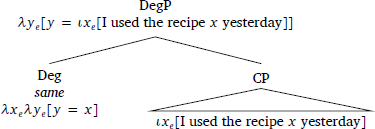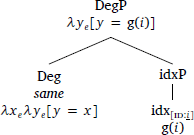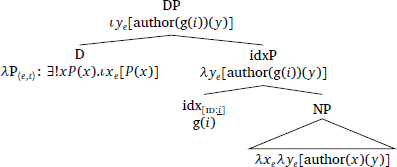1 Introduction
This paper contributes to the study of anaphora by examining the interaction between DP structure and nominal modifiers that support anaphoric interpretations. The point of departure for this investigation is the relatively recent attribution of anaphoric interpretations in definite descriptions such as the recipe in (1) to the presence of an index introduced within the functional structure of the DP (Elbourne 2005, Schwarz 2009, i.a.).
| (1) | I cooked with a new recipe for pancakes yesterday. I followed the recipe again today. |
On the view that anaphora is structurally encoded, definite descriptions giving rise to anaphora do so by virtue of containing an index-hosting head in their structure that is otherwise lacking in non-anaphoric (i.e., solely unique) definites. A proposal along these lines is illustrated in (2)–(3), taking Schwarz’s (2009) implementation as a starting point:
- (2)
- Anaphoric definite
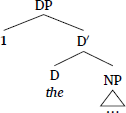
- (3)
- Unique definite

Given this analytical backdrop, the aim of this paper is to investigate how anaphoric modifiers interact with this proposed complexity within the structure of the DP. While the relationship between DP structure and modification has gone largely unaddressed in this line of work, the claim that indices are structurally encoded leads to predictions about the ways in which they might interact with nominal modifiers. The present paper takes same (Dowty 1985; Carlson 1987) as a case study to probe this question.
On the view that anaphora has a structural source, which component of the structure is responsible for introducing the anaphoric meaning – the modifier or the index head – is at this point an open question. Consider the definite description ‘the same recipe’ in (4), whose indefinite antecedent is introduced in the clause preceding it.
- (4)
- I cooked with a new recipe for pancakes yesterday. I followed the same recipe today.
In (4), it is not immediately clear whether same itself is anaphoric or, in the present line of inquiry, whether it is merely an NP modifier that is compatible with the semantics resulting from a structure along the lines of (2).
In what follows, I argue against the null hypothesis that same appears in an otherwise unchanged index-containing DP structure such as (2). Based on seemingly unrelated morphosyntactic behaviors, I argue instead that same encodes anaphora through distinct structural means by selecting for its own index-hosting head. I argue moreover that this selectional behavior results from the fact that, syntactically, same is an equative ‘degree’ head (Heim 1985; Alrenga 2007; Oxford 2010). Below, the structures in (5)–(6) offer a preview of the proposed difference underlying simple anaphoric definites and those modified by same. The crucial distinction is where idx is introduced: In (5) it is in the extended projection of N, while in (6), it is selected by Deg.
- (5)
- Anaphoric definite
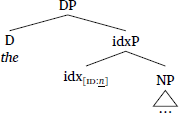
- (6)
- ‘Same’-modification
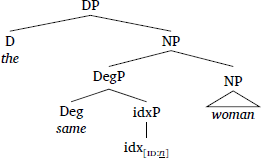
Beyond the morphosyntactic differences between definite descriptions with and without same in anaphoric contexts, I argue that the treatment of same as an equative head is further supported by a broader selectional alternation observed across equative expressions, namely one between an implicit argument that gives rise to anaphora, and an overt standard in the form of an as-relative (Carlson 1977b), in which an anaphoric reading need not obtain (Carlson 1987). Consider (7): ‘the same pancake’ is not anaphoric in this case, and can be used in out of the blue contexts (a ‘first mention’ or ‘referent-establishing’ definite, in Hawkins’s (1978) terms), thus distinguishing this environment from the ‘second mention definites’ found in cross-sentential contexts such as (4).
| (7) | I followed the same pancake recipe today [as-rc as I always do ]. |
Building on earlier proposals in Matushansky (2010a; b), I argue that this alternation is straightforwardly captured by the fact that idx and the as-relative both compete for the same syntactic position, which in the present analysis is the complement of Deg:
| (8) | a. | [DegP [Deg same ] [idxP ∅ ] ] | Anaphora | |
| b. | [DegP [Deg same ] [CP as … ] ] | As-relativization |
Narrowly, this paper offers arguments for the existence of more than one structural path to anaphora within the DP, which follows naturally upon comparison with the selectional requirements of equative heads more generally. As a result, new evidence is provided for the previously proposed idea that indices may occupy structural positions, and, novel to this paper, that these positions may vary. This study sheds light moreover on the characteristics of as-relatives embedded by same, which, unlike other types of as-relatives, are not well-studied in the literature. More broadly, this paper offers an account of the relationship between anaphora, modification, and relativization that ultimately offers a unified view of how these components interrelate in equative constructions.
The structure of this paper is as follows. Section 2 reviews previous arguments that indices are syntactically reified as heads in the structure of anaphoric definites, and introduces the open questions posed for this view by same-modification. Section 3 lays out the observed alternation between anaphora and as-relatives, and Section 4 introduces the proposal that same is syntactically an equative head that is part of a larger family of equative constructions. Section 5 applies the proposal to account for the morphosyntactic behaviors of definite descriptions with same, and offers a comparison to other (anaphoric) relational terms. Section 6 gives a matching analysis of as-relatives selected by same, and offers a brief comparison to that-relatives, thereby situating same within a larger family of equative and relative constructions. Section 7 concludes.
2 Indices and modification in anaphora
I offer in this section a brief review of previous claims that syntactically-encoded indices are responsible for giving rise to anaphora (Elbourne 2005; Schwarz 2009; Arkoh & Matthewson 2013; Simonenko 2014; Patel-Grosz & Grosz 2017; Schlenker 2017; Jenks 2018, i.a.). I then lay out the particular implementation of this view that I adopt, in which an index-hosting head idx projects its own functional phrase within an extended nominal projection (Simonenko 2014; Hanink 2018). I then turn to the questions posed by the availability of same in anaphoric definites for such a representation of indices.
2.1 Indices in the DP
Recent work on anaphora engages with the nature of indices, and particularly with the way in which they are formally represented in the syntax of definite descriptions. Broadly speaking, this line of research questions the idea that indices are merely subscripts on D or N, as they are often schematized in syntactic representations (following e.g., the Binding Theory of Chomsky 1981: Chapter 3, according to which each NP must be indexed by a single numerical index value at LF; see Fiengo & May 1994 for an overview).
More specifically, building on Elbourne (2005), Schwarz (2009) argues that German morphology provides evidence that indices occupy structural positions within anaphoric definites to the exclusion of their non-anaphoric (i.e., solely unique) counterparts: In German, the form of the definite article in anaphora differs from its form in non-anaphoric contexts, providing a morphological distinction that makes a cut along Heim’s (1982) notion of familiar vs. unique definites.1 This is observed through the fact that non-anaphoric definites allow for contraction with a preceding preposition (the ‘weak’ form of the article, in Schwarz’s terminology), as in (9), while ‘familiar’ definites whose reference must be resolved via an antecedent may not participate in this contraction (10), exhibiting the so-called ‘strong’ form instead.
- (9)
- Der
- the
- Empfang
- reception
- wurde
- was
- vom/#von
- by.the/by
- dem
- the
- Bürgermeister
- mayor
- eröffnet.
- opened
- ‘The reception was opened by the mayor.’ Schwarz 2009: 40
- (10)
- Hans
- Hans
- hat
- has
- einen
- a
- Schriftstelleri
- writer
- und
- and
- einen
- a
- Politikerj
- politician
- interviewt.
- interviewed.
- Er
- He
- hat
- has
- #vom/von
- from.the/from
- dem
- the
- Politikerj
- politician
- keine
- no
- interessanten
- interesting
- Antworten
- answers
- bekommen.
- gotten
- ‘Hans interviewed a writer and a politician. He didn’t get any interesting answers from the politician.’Schwarz 2009: 30
The crucial distinction is that in (9), ‘the mayor’ is a solely unique definite, uttered in a context in which world knowledge dictates that a given town has just one mayor (cp. Hawkins’s (1978) typology), while ‘the politician’ in (10) has already been introduced into the discourse, making it familiar.2 Based on this distinction, Schwarz reaches the generalization that the definite article may not contract when a definite description is anaphoric (see also Hartmann 1978, Haberland 1985, and Cieschinger 2006).3
To capture the morphological reflex of this generalization, Schwarz proposes that the definite determiner may not contract with a preceding preposition in case an anaphoric index (notated as ‘1’) intervenes in the structure of the DP, which D selects as its specifier, as in (11) (cf. Elbourne 2005; see also Patel-Grosz & Grosz 2017; Jenks 2018).4 The unique form lacks this index, and contraction is therefore possible (12):
- (11)
- Schwarz’s anaphoric definite
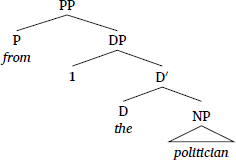
- (12)
- Schwarz’s unique definite
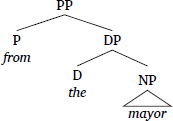
Schwarz then attributes the interpretational differences to the meanings for the definite article in (13)–(14), which differ in whether anaphoricity is hardwired in. The denotation in (13) for the unique (weak) form represents a standard Fregean/Strawsonian meaning for the determiner, and results in a DP denoting a unique individual.5
| (13) | a. | [[theweak]]: λP⟨e,t⟩: ∃!xP(x).ιxe[P(x)] | |
| b. | [dp [d the ] [ NP ]] | ||
| c. | [[the mayor]]: ιxe[mayor(x)] | mod. Schwarz 2009: [148] |
The anaphoric (strong) form then differs in that D must take an index as an argument (in addition to its nominal complement), as schematized in (14). This index introduces a free variable that picks out an antecedent via an assignment function according to the Pronouns and Traces rule of Heim & Kratzer (1998).
| (14) | a. | [[thestrong]]: λP⟨e,t⟩λye: ∃!xP(x) & x = y.ιxe[P(x) & x = y] | |
| b. | [dp 1 [d′ [d the ] [ NP ]]] | ||
| c. | [[the politician]]g: ιxe[politician(x) & x = g(1)] | mod. Schwarz 2009: 260 |
Going forward, I follow the spirit of Schwarz’s (2009) analysis, but I adopt the revised implementation in Simonenko 2014 and Hanink 2017; 2018, in which syntactic indices head their own phrase (see also Hanink 2021). Hanink (2018) argues in particular that the structure of the anaphoric DP is instead as in (15), in which idx is not a specifier, but a head within the extended projection of N, on a par with other functional layers such as NumP (Ritter 1991; 1993; see Alexiadou et al. 2007 for an overview).6
- (15)
- Revised structure for anaphoric definites
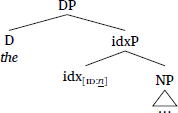
As argued by the above authors, one benefit of this implementation is that it allows for a single denotation for D across both anaphoric and non-anaphoric interpretations (cf. (13)–(14)), as anaphoricity within the DP is divorced from D itself and placed entirely on idx. Idx is not a semantic argument of D but instead a nominal modifier that has undergone the ident type shift (Partee 1986) from type e to the property meaning in (16) (as also in Elbourne 2005, though in a different syntactic position).
| (16) | [[idx[id: i]]]g: λye[y = g(i)] |
This modifier of type ⟨e, t⟩ then undergoes Predicate Modification (Heim & Kratzer 1998) with the NP, and we arrive at precisely the DP meaning proposed by Schwarz (2009), though in this case by different means:
| (17) | [[the politician]]g: ιxe[politician(x) & x = g(i)] | cf. (14c) |
In order to more explicitly explain the contraction contrast, Hanink (2018) adopts an analysis couched in Distributed Morphology (Halle & Marantz 1993). Hanink argues that P-D contraction is the result of postsyntactic Lowering (Embick & Noyer 2001: 561), a type of merger that applies hierarchically to head-complement sequences, after all syntactic operations, but prior to linearization. This process is schematized in (18).
| (18) | Lowering of X0 to Y0 |
| [xp X0 … [yp … Y0 … ]] → [xp … [yp … Y0 + X0 … ]] |
Similar to variation in head movement, whether or not a head triggers Lowering is specified on a head-by-head basis in a given language. For instance, Embick & Noyer (2001) analyze “affix hopping” in English tense marking as a case of T lowering to v (20):
| (19) | Lowering of T0 to v0 in ‘played’ |
| [tp -ed … [vp … play … ]] → [tp … [vp … play + -ed … ]] |
Adopting this idea, Hanink (2018) argues that P-to-D lowering is a specified process in German, resulting in contraction in the general case, as schematized in (20):7
- (20)
- P-to-D Lowering
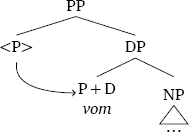
Crucially, the structure of anaphoric DPs is more complex than (20) in that it includes idx. In this case, Hanink (2018) argues that idx itself triggers lowering of D. Adopting a bottom-up, cyclic approach to postsyntactic operations (e.g., Embick 2010), D-to-idx lowering (21) precedes P-to-D lowering. This then bleeds the environment for contraction, as D, itself having lowered, is no longer present within the relevant domain to trigger lowering of P (22). (This particular approach will be further motivated in Section 5.1, which evaluates the behavior of same in contraction environments.)8
- (21)
- D-to-idx Lowering
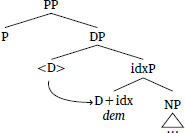
- (22)
- P-to-D Lowering bled
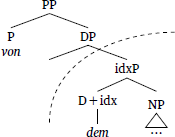
Taken together, the accounts reviewed in this section offer semantic as well as morphosyntactic evidence that indices occupy structural positions in anaphoric DPs, a proposal that has been further supported by cross-linguistic work revealing similar effects (Akan, Arkoh & Matthewson 2013, cf. Bombi 2018; ASL, Schlenker 2017; Cantonese, Jenks 2018; see Schwarz 2019 for a recent overview). Going forward, I adopt the proposal laid out above that the head of idxP is the locus of anaphoricity in the DP, and that P-D contraction is contingent on whether D-to-idx Lowering is able to apply first.
2.2 Anaphoric modification in the DP
We now turn to the relationship between structurally-encoded indices and anaphoric modifiers within the DP. While there has been a good deal of work on anaphoric modifiers such as same and different (i.a. Alrenga 2007; 2009; Dotlačil 2010; Brasoveanu 2011; Bumford & Barker 2013; Charnavel 2015; Hardt & Mikkelsen 2015; see also Dowty 1985; Carlson 1987; Moltmann 1992; Beck 2000), these works focus by and large on various aspects of interpretation, leaving structural questions unaddressed (though see Oxford 2010). As a testing ground for investigation, I focus on the modifier same, as in (23):
| (23) | I cooked with a new recipe for pancakes yesterday. I followed the same recipe today. |
On what can be taken as the null hypothesis in the current view, same is a modifier within an idxP-hosting DP structure, just as in any unmodified anaphoric definite (e.g., (15)). If this is correct, then the morphosyntactic behaviors of anaphoric DPs with and without same should be identical. I argue however that this is not the case: Instead, same has a distinct syntax and encodes anaphora in its own way. On this view, we expect to see morphosyntactic differences between definite descriptions with and without same. I briefly introduce data supporting this prediction below before offering an analysis that accounts for the observed differences in Section 3.
Our starting clue to the structural difference between anaphoric definites with and without same comes from an apparent anomaly in P-D contraction behavior in German. Recall Schwarz’s generalization that the definite article may not contract with a preceding preposition in anaphora. As Schwarz points out however, anaphoric same appears to contradict his generalization, a puzzle that he leaves for future work.9 The puzzle is exemplified in (24)–(25): While the definite descriptions are anaphoric in these examples, the contracted form of the article is nevertheless preferred.10 (N.B. der/die/dasselb- is written as a single orthographic word):11
- (24)
- Hanne
- Hanne
- wohnt
- lives
- seit
- since
- Jahren
- years
- in
- in
- einem
- a
- schönen
- nice
- Berliner
- Berlin
- Altbau.
- Altbau.
- Ihre
- Her
- Cousine
- cousin
- Maria
- Maria
- wohnt
- lives
- im
- in.the
- selben/#in
- same/#in
- demselben
- the.same
- Altbau.
- Altbau
- ‘Hanne has lived in a nice Berlin Altbau for years. Her cousin Maria lives in the same Altbau.’
- (25)
- Das
- the
- Schild
- sign
- hängt
- hangs
- an
- on
- einem
- a
- Haus.
- house.
- Am
- On.the
- selben/#an
- same/#on
- demselben
- the.same
- Haus
- house
- findet
- find
- ihr
- you
- eine
- a
- Jahreszahl,
- date,
- die
- rel
- man
- one
- deutlich
- clearly
- sehen
- see
- kann.
- can
- ‘The sign’s hanging on a house. On the same house you’ll find a date that one can see clearly.’
These data constitute evidence against the null hypothesis: If same appeared in an otherwise unchanged DP structure, contraction should be blocked: idx should trigger lowering of D to idx (see (21)) on Hanink’s account (or 1 would intervene between P and D as in (11), on Schwarz’s account), thus bleeding the environment for P-D contraction. This prediction is crucially not borne out, and we therefore find evidence that distinct structures underlie anaphoric definites with and without same.
Beyond P-D contraction in German, another more general and well-established clue to this proposed structural distinctness is that only definite descriptions with same license an as-relative (Carlson 1987) as in (26a) (cf. 26b), a characteristic that has long been attributed to same’s selectional properties (Heim 1985).
| (26) | a. | I followed the same pancake recipe today [as-rc as I always do ]. |
| b. | *I followed the pancake recipe today [as-rc as I always do ].12 |
While this is by no means a new observation, I argue in what follows that understanding the ability of same to introduce an as-relative can shed light both on the structure in which it occurs as well as the way in which it gives rise to an anaphoric interpretation.
Looking forward, the core of the analysis relates the availability of both anaphora and as-relatives to the selectional properties of equative heads more broadly, in a way that can explain the seemingly unrelated puzzle from German contraction. As previewed in Section 1, I contend that, unlike anaphoric definites without same, anaphoric definites with same have an underlying syntax in which same is an equative head that selects for idx as an implicit argument (Baker et al. 1989, see Williams 2015 Chapter 5 for overviews). Crucially, I propose, building on Matushansky (2010a; b) and Charnavel (2015), that idx and the as-relative compete for the same position ((27)–(28)) – as the complement of Deg – explaining why they alternate with one another.
- (27)
- Selection of idx
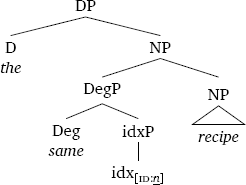
- (28)
- Selection of an as-relative
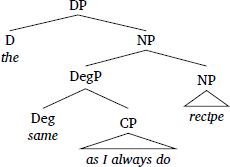
3 The alternation between anaphora and as-relatives
In this section, I argue that the selectional behaviors of same follow naturally if same realizes an equative head. Below, I motivate this syntactic proposal on the basis of a comparison between same and the equative heads as and such, which likewise alternate between an anaphoric interpretation and one in which an as-relative is present.
Recall the two seemingly distinct uses of same discussed at the end of Section 2.2: a cross-sentential anaphoric use as in (29), and one with an as-relative, as in (30).
| (29) | Anaphora |
| I used a new recipe for pancakes yesterday. Today, I used the same recipe. |
| (30) | As-relative |
| Today I used the same pancake recipe [as-rc as I used yesterday ]. |
Both constructions encode identity; the difference is that (29) involves an anaphoric dependency, while (30) is not anaphoric, and instead involves the introduction of an as-relative. Crucially, this alternation demonstrates that the presence of an as-relative obviates the need for an antecedent, which is obligatory with same on its cross-sentential use.13 That is to say, the use of same is felicitous in out-of-the-blue contexts/first-mention definites just in case an as-relative is introduced; unlike in (29), there is no antecedent in (30), but the use of same is felicitous nonetheless.14
It is crucial for our purposes that precisely this alternation is attested for other equative heads. For example, it is observed in degree equatives introduced by as (31) (Landman 2006; Umbach 2007; Anderson & Morzycki 2015) as well as in kind equatives introduced by such (32) (e.g., Bolinger 1972; Bresnan 1973; Carlson 1977b; Siegel 1994; Wood 2002; Landman & Morzycki 2003; Landman 2006; Anderson & Morzycki 2015):
| (31) | Degree equatives | |
| a. | Anaphora | |
| Fresh fruit is good in smoothies, but frozen fruit is just as good. | ||
| b. | As-relative (standard of equation) | |
| Frozen fruit is just as good in smoothies [as-rc as fresh fruit is ]. | ||
| (32) | Kind equatives | |
| a. | Anaphora | |
| Dogs with long hair are quite difficult to bathe. Floyd here is such a dog. | ||
| b. | As-relative (standard of equation) | |
| Such a dog [as-rc as Floyd ] is quite difficult to bathe. | ||
Drawing on previous proposals for these constructions, I argue that a unified syntactic analysis can be achieved if equative heads share the same selectional requirements, and if same is a member of this class alongside as and such.
3.1 Degree equatives
Beginning with degree equatives, the examples in (31) demonstrate that as alternates between an anaphoric reading and one in which an as-relative is present instead. While anaphoric uses of as are not well-studied in the literature (though see Umbach 2007 and Hohaus 2015), I propose that they can be explained along the lines of the proposal for anaphoric comparatives made by Alrenga et al. (2012) and Hohaus (2015) (see also Beck et al. (2012) on so-called ‘contextual comparatives’). In particular, Alrenga et al. demonstrate that comparatives alternate between an anaphoric use and an overt standard of comparison in the form of a than-clause:
| (33) | Comparatives | |
| a. | Anaphora | |
| Apples are interesting, but pomegranates are more interesting. | ||
| b. | Than-clause (standard of comparison) | |
| Pomegranates are more interesting [than-pp than apples are ]. | ||
Alrenga et al. account for this contrast by proposing that an implicit degree argument competes for the same syntactic slot as the than-clause, that is, in addition to a gradable adjective, Deg selects either for an overt standard, or for an implicit degree argument, giving rise to an anaphoric interpretation. The parallel to equatives is then as follows: While in (34) the as-relative provides the overt standard of equation, as on its anaphoric use selects for an implicit degree argument (35) instead.15
- (34)
- Overt standard
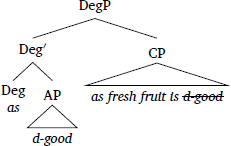
- (35)
- Anaphoric standard
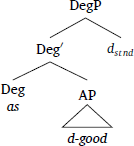
Both the implicit degree argument and the as-relative are of the same type – d – making sense of this syntactic alternation. Adopting the view that gradable predicates denote relations between degrees and individuals (Creswell 1976; von Stechow 1984; Heim 1985; Kennedy 1999), a standard semantics for degree equatives (with an overt as-relative) is as in (36) (Horn 1972; Seuren 1984; von Stechow 1984; Schwarzschild & Wilkinson 2002). As imposes a weak linear ordering between maximal degrees, in this case contributed by the matrix and embedded clauses, respectively:
| (36) | [[as]] ([[frozen vegetables are good]])([[fresh fruit is good]]) |
| =1 iff max(d-good(frozen fruit)) ≥ max(d-good(fresh fruit)) |
In anaphoric equatives, where an as-relative is lacking (35), the standard is instead supplied by the implicit degree argument (see Umbach 2007 for a similar, but slightly different semantic analysis of the German counterpart to as, ‘so’):
| (37) | [[as]] (dstnd)([[good]])([[frozen fruit]]) |
| =1 iff max(d-good(frozen fruit)) ≥ dstnd |
3.2 Kind equatives
Beyond degree equatives, a similar state of affairs has been observed moreover by Anderson & Morzycki (2015) for kind equatives, who treat such as a degree head in its own right. Building on Landman & Morzycki 2003, Anderson & Morzycki argue for a view of degrees according to which they are sets of (Davidsonian) state-kinds (cf. Parsons 1970; Baglini 2015; Wellwood 2015; 2019), with one key result being that such is analyzed syntactically as a degree head.
These authors present evidence for the unification of degrees and kinds from the fact that such has a degree use in addition to its better-studied kind use. For instance, (38a) shows such as a degree exclamative (Bolinger 1972; Bresnan 1973; Carlson 1977a); (38b) shows such on an extent reading (Meier 2003; Castroviejo-Miró 2011).16
| (38) | a. | That man is such an idiot. |
| b. | He is such a tall man that he might not fit in the car. |
Independently from Alrenga et al. (2012), Anderson & Morzycki (2015) account for this alternation with the now familiar proposal that such selects either for an overt standard of equation in the form of an as-relative (39), or an implicit kind variable instead, giving rise to an anaphoric interpretation (40) (see also Carlson (1977b), who argues that the as-relative itself supplies the anaphoric relation):17
- (39)
- Overt standard

- (40)
- Anaphoric standard

The semantics that Anderson & Morzycki propose is also such that both complements of such are of the same type – k. Such itself has the meaning in (41), which takes a kind k as its first argument (where ∪ is Chierchia’s (1985) up operator, shifting kinds to properties) and returns a property of individuals instantiating that kind.
| (41) | [[such]]: λkkλxe[∪k(x)] |
In cases where the standard is provided by an as-relative (39), the embedded clause is property-denoting (following λ-abstraction) (42a), but then undergoes the existential closure type shift (Partee 1986) (42b), as previously proposed for free relatives by Caponigro (2003; 2004).18
| (42) | a. | [[as Floyd is]]: λkk[∪k(Floyd)] |
| b. | shift λ Q⟨k,t⟩∃kk[∪k(Floyd) & Q(k)] |
The embedded clause then undergoes QR, rendering the meaning of the matrix clause that in (43), with abstraction over a kind variable of type k:
| (43) | [[such a dog ____ barked]]: λk′k∃ xe[∪k′(x) & dog(x) & barked(x)]] |
The property in (43) then composes with (42b), resulting in (44), which states that the kind of dog that Floyd instantiates is also instantiated by the dog that barked:
| (44) | [[Such a dog as Floyd barked]]: |
| ∃kk[∪k(Floyd) & ∃ xe[∪k(x) & dog(x) & barked(x)]] |
In cases of anaphora on the other hand (e.g., (32a)), such selects syntactically not for a CP, but for an implicit kind argument instead, on a par with anaphoric comparatives à la Alrenga et al. 2012 and the current proposal for degree equatives. The resulting meaning may then undergo another type-shift depending on its argument position, again resulting in a similar derivation in both cases.19
| (45) | [[such a dog]]: λxe[∪k(x) & dog(x)] |
3.3 Interim summary
Taken together, a parallel emerges between same, as, and such on the view that they are all equative degree heads that show a common selectional alternation: one between an implicit argument and an as-relative. Same makes a natural addition to the paradigm: while as equates degrees and such equates kinds, same equates individuals. The proposal that all of these morphemes take as-relatives to establish identity meanings is moreover in line with Bacskai Atkari’s (2016) observation that the general purpose of as-relatives is to establish identity, regardless of the type of matrix material they compose with.
4 same as an equative head
I now turn to a more explicit analysis of same, making sense of same’s selectional requirements through a comparison with those discussed above for as and such. The proposal predicts that anaphoric definites with and without same should display distinct morphosyntactic behaviors, which I return to in Section 5.
4.1 Previous work on same as Deg
The claim that same is a degree head goes back to Heim (1985), who notes that degree constructions do not only target positions on a dense scale, but can also target binary values on a scale of [0,1], i.e., the scale of (non-)identity. More recently, Alrenga (2007) has argued that same is a degree head based on its gradable behavior in what he calls similarity comparatives. Alrenga shows that the gradability of same is observed in that both degree equatives and similarity comparatives may be modified by the same set of closed-scale approximating modifiers (Huddleston & Pullum 2002), as in (46a-b):
| (46) | a. | Degree equative |
| Frozen fruit is {almost, nearly, just about, not quite} as good as fresh fruit. | ||
| b. | Similarity comparative | |
| Frozen fruit is {almost, nearly, just about, not quite} the same as fresh fruit. |
To capture this distributional equivalence, Alrenga argues that – beyond its identity reading – same may make reference to degrees on a measurement scale of similarity, where same encodes a relation expressing the grade of similarity between two objects. This is what unites similarity and degree equatives, explaining why both are able to occur with the set of modifiers in (46). Crucially, on Alrenga’s (2007) account, same is not an adjective, but a degree expression on a par with matrix as in degree equatives.
As Alrenga points out however, the modifiers in (46) are not possible in identity cases where the equative establishes a relation between individuals, rather than degrees, as illustrated with their badness in (47) where token identity holds between dogs:20
| (47) | You saw *{almost, nearly, just about, not quite, roughly} the same dog as I did. |
On this basis, Alrenga draws the conclusion that same is polysemous between a gradable and non-gradable use; similarity same encodes an ordering between degrees in a fashion similar to as in degree equatives, while identity same encodes identity between individuals. In both cases, the purpose of this head is to express the absence of dissimilarity. Notably however, beyond the modifiers that Alrenga discusses in (46), we find a similarity between degree equatives and even non-gradable same. For instance, both may be modified by exactly, which in Lasersohn’s (1999) terms effectuates an identity mapping:
| (48) | a. | Degree equative |
| I am exactly as tall as Mary is. | ||
| b. | Same-equative | |
| I saw exactly the same dog as Mary did. |
I therefore take Alrenga’s work one step further and argue that individual-equating same is also syntactically an equative head, not an adjective.21 While Oxford (2010) reaches the same conclusion based on same’s ability to take an as-relative, I show that such cases can be unified with the anaphoric use of same on the present approach.
Before moving on, I clarify that I am using the term degree head purely syntactically, making reference to the shared selectional properties of this head across equatives and comparatives. Another possible label for DegP in this case is for example ‘EquatP’, proposed by Brandner (2016) and discussed by Bacskai-Atkari (2016). I note that while I do not assign identity-same a degree semantics here (see below), it might well be the case that this head may be analyzed with reference to degrees, related to its gradable use (see e.g., Alrenga 2007: Chapter 4 for discussion).22 I must leave this matter aside, focusing instead on the syntactic properties of degree heads related to their selectional behavior.
4.2 Basic proposal
If same has the same equative degree syntax as both as and such, it immediately explains why same shows the same selectional alternation between an implicit argument and an overt standard as those heads do. I therefore propose that identity same may select either for an overt standard of equation in the form of an as-relative (49), or for the implicit individual argument idx (50), resulting in anaphora in a related but distinct way from definite descriptions without this modifier.
- (49)
- Overt standard
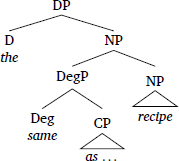
- (50)
- Anaphoric standard
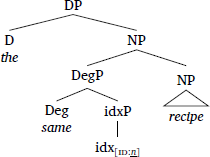
Turning to interpretation, while the precise meaning of same has received a good deal of attention in recent literature (Alrenga 2006; 2007; 2009; Barker 2007; Charnavel 2010; 2015; Hardt et al. 2012; Hardt & Mikkelsen 2015), going forward, I adopt the modest proposal that it relates two individuals in a relationship of equation (Heim 1985; Alrenga 2009; Matushansky 2010a; b):23
| (51) | [[same]]: λxeλye[y = x] |
Adopting this meaning along with the structure in (49), composition with an as-relative proceeds as follows. (I return to a detailed analysis of the internal make-up as-relatives in Section 6.) The as-relative and implicit variable are both individuals of type e; while this is a straightforward enough meaning for the implicit variable, I treat as-relatives as properties of individuals that undergo the iota type-shift (Partee 1986) to achieve the individual meaning, on a par with the treatment of definite free relatives proposed by Caponigro (2003; 2004):
| (52) | [[as I used ____ yesterday]]: ιxe[I used the recipe x yesterday] |
The as-relative is then of the right type to saturate the first argument of same, as in (53):
- (53)
The resulting DegP composes with the matrix NP recipe through Predicate Modification, before composing with the definite article (cp. the structure in (49)):
| (54) | a. | [[same recipe as I used yesterday]]: | |
| λye[recipe(y) & y = ιxe[I used the recipe x yesterday]] | pm | ||
| b. | [[the same recipe as I used yesterday]]: | ||
| ιye[recipe(y) & y = ιxe[I used the recipe x yesterday]] | fa |
On its anaphoric use on the other hand (e.g., (50)), same selects instead for idx as its first argument, resulting in what is essentially the property of being anaphoric, as in (55):24
- (55)
With this meaning for DegP in place, the interpretation of same on its anaphoric use is then as in (56), once the property denoted by DegP undergoes Predicate Modification with the property denoted by the noun it modifies (cp. the structure in (50)):
| (56) | a. | [[recipe]]: λze[recipe(z)] | |
| b. | [[same recipe]]g: λye[recipe(y) & y = g(i)] | pm | |
| c. | [[the same recipe]]g: ιye[recipe(y) & y = g(i)] | fa |
The result is a definite description containing a free variable that may refer back to an antecedent, much in the same way as described for unmodified anaphoric definite descriptions in Section 2.1. Crucially, while the result is the same – (56) has the same meaning as individual anaphora without same (see also Brasoveanu 2011) – the underlying structures are distinct.25 Again, while this is most likely a simplification of the semantic contribution of same, it derives two distinct structural paths to anaphora, supporting the idea that indices may enter the derivation in different ways.26
4.3 A comparison to related proposals
Before moving on, I offer a brief comparison to previous analyses that the present proposal builds on, found in Matushansky 2010a; b and Charnavel 2015. The crucial similarity with these proposals is that they likewise aim to capture the fact that same is compatible with either an anaphoric interpretation or a comparative-type clause instead.
First, Matushansky (2010a; b) offers an analysis of same very similar to the structures proposed in (49)–(50). In particular, she argues that same’s internal argument is either a contextually supplied antecedent (on its anaphoric reading), or a CP (in cases with an overt standard):
- (57)
- Same as ident (Matushansky 2010b: 21–26)
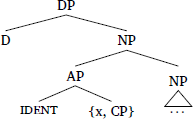
Crucially, as shown in (57), Matushansky assigns same the category of an adjective and argues that it is the lexicalization of Partee’s (1986) ident type-shift (with the same semantics adopted in the previous section, from Heim 1985). My proposal therefore differs from Matushansky’s in the treatment of same as the equative head of an NP-modifying DegP, which offers a unified analysis with other equative degree heads such as as and such.27 (I return to Matushansky’s (2010a) analysis of as-relatives and empirical challenges for it in Section 6).
Second, Charnavel 2015 proposes a related account of same and particularly different in French according to which they are relational adjectives (see also Safir 1996). The meaning she proposes for même ‘same’ is shown in (58):
| (58) | [[même]]: λ xeλ ye.∀P(x) ∈ C[P(x) = P(y)] (C is a set of contextually relevant properties, preferably including all possible properties) Charnavel 2015: 153 |
Similarly, Charnavel proposes that same may select a ‘comparative clause’ (introduced by que in French) or occur with what she calls an implicit DP. While Charnavel does not offer a detailed syntactic analysis, she writes that anaphoric same constructions involve an implicit argument x, in which this x is underspecified and interpreted pragmatically as an anaphoric pronoun (see also Dowty 1985), as in (59) (Charnavel 2015: 151). (Charnavel is not explicit about the way in which same composes with an as-relative.)
| (59) | Lucie watched Frida yesterday. As for me, I watched the same movie as xpronoun.’ |
In sum, while the present accounts builds on these proposals, it diverges specifically in its explicit treatment of same as an equative head (building here instead on Heim 1985; Alrenga 2007; 2009; Oxford 2010) rather than an adjective, in a way that makes sense of the relationship between identity-same and similarity comparatives, as well as the morphosyntactic differences between same and adjectival modifiers (see Section 5). The proposal also offers an explicit representation of same’s implicit argument as idx, and unifies the selectional properties of same with those of other equative heads.
5 The morphosyntax of anaphora with and without same
With the analysis laid out, we now return to the puzzling behavior of German selb- introduced in Section 2.2. Section 5.1 revisits the unexpected behavior of same with respect to P-D contraction within the context of the present analysis, while Section 5.2 offers a comparison between selb- and other relational terms that have been argued to be anaphoric.
5.1 The German contraction facts revisited
The present proposal contends that anaphoric definites with and without same are structurally distinct, differing crucially in the position in which idx is introduced. Naturally, this claim leads to the prediction that we should find morphosyntactic reflexes of this difference. Section 2.2 introduced two morphosyntactic behaviors of same that appeared to support this prediction: i) the anomalous behavior of same in German contraction environments, and ii) the availability of as-relatives only in definite descriptions with same. Having argued in Section 4 that the selectional properties of same explain the alternation between anaphora and as-relatives, I now return to the contraction behavior of same in German and show how the present account accounts for this unsolved puzzle.
The anomaly presented in Section 2.2 is that P-D contraction is licensed in anaphoric environments just in case same is present, shown in the repeated example in (60). This is unexpected, as the presence of idx in anaphoric definites otherwise blocks contraction.
- (60)
- Hanne
- Hanne
- wohnt
- lives
- seit
- since
- Jahren
- years
- in
- in
- einem
- a
- schönen
- nice
- Berliner
- Berlin
- Altbau.
- Altbau.
- Ihre
- Her
- Cousine
- cousin
- Maria
- Maria
- wohnt
- lives
- im
- in.the
- selben/#in
- same/#in
- demselben
- the.same
- Altbau.
- Altbau
- ‘Hanne has lived in a nice Berlin Altbau for years. Her cousin Maria lives in the same Altbau.’= (24)
Before presenting the analysis, I briefly rule out two alternative explanations for this behavior. The first is the idea that the presence of any modifier licenses contraction, and that this behavior is therefore not particular to same. This is crucially not the case however, as seen for example in (61), in which same is replaced by the adjective blue. In this case, the definite article may not contract – much in accordance with Schwarz’s generalization:
- (61)
- Gestern
- yesterday
- habe
- have
- ich
- I
- ein
- a
- grünes
- green
- und
- and
- ein
- a
- blaues
- blue
- Haus
- house
- gesehen.
- seen
- #Am/An
- on.the/on
- dem
- the
- blauen
- blue
- Haus
- house
- gibt
- gives
- es
- it
- eine
- a
- Jareszahl,
- date,
- die
- rel
- man
- one
- deutlich
- clearly
- sehen
- see
- kann.
- can
- ‘Yesterday I saw a green and a blue house. On the blue house there’s a date that one can see clearly.’
Another possibility is that contraction is preferred because definites with same are not in fact anaphoric, but are unique uses of the definite article that are independently licensed in anaphoric contexts. Evidence against this idea comes from the observation that same may appear in covarying contexts, argued to be the sine qua non environment for diagnosing anaphoricity in languages with different definiteness-marking strategies (Schwarz 2009; Jenks 2018).28 A covarying context is shown in (62) (adapted from a similar example without same in Schwarz 2009: 242): (62a) shows that, in definites without same, the strong article is preferred in such contexts, consistent with the idea that they involve anaphora. (62b) shows two things: First, same is likewise felicitous in anaphoric covarying contexts, and second, that contraction is observed in this environment as well (as in non-covarying contexts).
- (62)
- Jedes Mal, wenn mir bei einer Gutshausbesichtigung ein Zimmer besonders gefällt, finde ich später heraus, dass eine berühmte Person …
- Every time I particularly like a room during a mansion tour, I later find out that a famous person …
- a.
- eine
- a
- Nacht
- night
- #im/in
- #in.the/in
- dem
- the
- Zimmer
- room
- verbracht
- spent
- hat.
- has
- ‘has spent a night in the room.’
- b.
- eine
- a
- Nacht
- night
- im
- in.the
- selben/#in
- same/#in
- demselben
- the.same
- Zimmer
- room
- verbracht
- spent
- hat.
- has
- ‘has spent a night in the same room.’
From the above data we can conclude not only that same is exceptional in inhibiting contraction, but also that definites with same in cross-sentential anaphora are truly anaphoric. The emerging puzzle is therefore that P-D contraction is licensed in anaphoric definites just in case same is present, which is unexplained if same is simply an adjective, like blue, that co-occurs with the anaphoric index as on Schwarz’s (2009) or Hanink’s (2018) account. These contraction data are therefore a crucial clue that anaphoric definites with same involve a different underlying structure from those without this modifier.
On the current proposal, we can now make sense of this contraction anomaly as a result of the fact that DegP is present in the structure. One crucial characteristic of Lowering is that it may not result in the displacement of a head into an adjunct: A head X0 may only lower to Y0 iff Y0 is the head of X0’s complement (Embick & Noyer 2001: 561, see also Bobaljik 1994). For example, returning to the case of affix hopping in English from Embick & Noyer, an adjunct such as loudly is not a suitable host for Lowering:
| (63) | a. | Mary [tp ti [vp loudly play-edi the trumpet ]]. |
| b. | *Mary [tp ti [vp loudly-edi play the trumpet ]]. |
In the case of anaphoric same, idx is housed in an adjunct (DegP) and is likewise not a suitable host for lowering. The correct environment for D-to-idx Lowering is therefore not met (64), allowing P-to-D lowering to go ahead, resulting in P-D contraction.
- (64)
- D-to-idx Lowering blocked
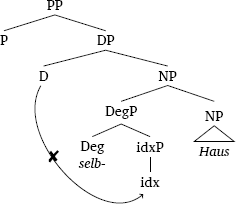
- (65)
- P-to-D Lowering
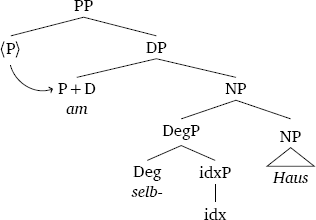
Before moving on, I note that nothing in the present account rules out the presence of idxP in the extended projection of N (cp. (15)), such that idx is introduced in two positions in the structure (as the complement of Deg, and in its typical position in anaphoric definites). This state of affairs predicts that non-contraction should in fact be possible in anaphoric definites with same, resulting in a structure containing two indices. To this end, it is worth pointing out that non-contraction in this case is not categorically ungrammatical.29 Consider for example (66), in which im selben is replaced with in demselben.
- (66)
- #Hanne
- Hanne
- wohnt
- lives
- seit
- since
- Jahren
- years
- in
- in
- einem
- a
- schönen
- nice
- Berliner
- Berlin
- Altbau.
- Altbau.
- Ihre
- Her
- Cousine
- cousin
- Maria
- Maria
- wohnt
- lives
- in
- in
- demselben
- the.same
- Altbau.
- Altbau
- ‘Hanne has lived in a nice Berlin Altbau for years. Her cousin Maria lives in the same Altbau.’
One way of interpreting this is that the presence of two coreferential indices is redundant and therefore pragmatically dispreferred (see also footnote 21), though I leave the precise discourse conditions for each use to future work.
In summary, a more detailed look at German supports the proposal that definite descriptions with and without same are built from different underlying structures whose morphosyntactic differences are conditioned by the part of the structure in which idx is introduced; this proposed difference is consistent moreover with the ability of same to introduce an as-relative. In the next subsection, I offer a comparison between same and relational adjectives that have been argued to be anaphoric. I show that such terms pattern differently from same with respect to how their anaphoric interpretation comes about, offering further support for the idea that anaphora with same is syntactically encoded, and that same does not pattern with adjectives in this regard.
5.2 Same, bridging, and relational terms
I argued above that the lack of P-D contraction with same is explained if idx in such cases is selected by Deg, rather than by D as in simple anaphoric definites. One question that emerges from this claim is how same compares to other relational terms that have likewise been argued to involve an implicit argument (Mitchell 1986; Partee 1989; see also Condoravdi & Gawron 1996, a.o.). For example, relational adjectives such as local are known to have a discourse anaphoric use, as in (67):
| (67) | a. | A reporter for the Times got seriously drunk. | |
| A local bar was selling cheap beer. | Condoravdi & Gawron 1996: 5 |
While Partee (1989) points out that the presence of a null pronoun might be responsible for the anaphoric interpretation in such cases (ultimately rejecting this approach, cf. Bhatt & Pancheva 2006), another possibility is that local imposes restrictions on the context in a more global sense, a view adopted by Condoravdi & Gawron 1996. Condoravdi & Gawron argue that implicit arguments in relational terms are interpreted along the lines of definite descriptions in Heim’s (1982) sense, which is to say that they impose particular familiarity conditions on the context in which they are uttered. On this view, the use of local requires some kind of accommodation (see Condoravdi & Gawron 1996: 15), in this case of a new variable that is assigned to a particular location relative to the context, even if that location has not been explicitly introduced by an antecedent.
Importantly, Condoravdi & Gawron (1996) do not argue for a syntactic representation of this variable. Relevant for our purposes is that Condoravdi & Gawron draw in their analysis a connection between relational terms such as local and definite descriptions that may also be accommodated without an explicit antecedent, as in (68):
| (68) | The Porsche lurched to a stop. | |
| The engine was smoking. | Condoravdi & Gawron 1996: 14 |
The use of the definite the engine in (68) constitutes a case of bridging (or associative anaphora, Clark 1975; Hawkins 1978). The availability of local in similar contexts (in that no explicit location is introduced as an antecedent in (67a)) leads Condoravdi & Gawron (1996) to conclude that implicit arguments behave like bridged definite descriptions, and not like pronouns, as the latter require an overt antecedent to be used anaphorically.
Importantly, Schwarz (2009) investigates bridging contexts with unique and anaphoric definites in German, and shows that not all bridging contexts are alike. Instead, different types of bridging relations result in different forms of the definite article. In particular, Schwarz shows a distinction between what he calls producer-product bridging and part-whole bridging. In the former, the anaphoric form of the article is used (69), while in the latter, the non-anaphoric form is (70):
- (69)
- Producer-product bridging (Schwarz 2009: 51)
- Das
- the
- Theaterstück
- play
- missfiel
- displeased
- dem
- the
- Kritiker
- critic
- so
- so
- sehr,
- much,
- dass
- that
- er
- he
- in
- in
- seiner
- his
- Besprechung
- review
- kein
- no
- gutes
- good
- Haar
- hair
- an
- on
- dem/#am
- the/on.the
- Autor
- author
- ließ.
- left
- ‘The play displeased the critic so much that he tore the author to pieces in his review.’
- (70)
- Part-whole bridging (Schwarz 2009: 52)
- Der
- the
- Kühlschrank
- fridge
- war
- was
- so
- so
- groß,
- big,
- dass
- that
- der
- the
- Kürbis
- pumpkin
- problemlos
- unproblematic
- #in
- in
- dem/am
- the/in.the
- Gemüsefach
- vegetable-drawer
- untergebracht
- stored
- warden
- be
- konnte.
- could
- ‘The fridge was so big that the pumpkin could easily be stowed in the crisper.’
Schwarz argues that cases of producer-product bridging are special in that they involve two-place relational terms such as author, whose meanings necessarily encode an internal argument as in (71), differentiating them from one-place nouns such as crisper:
| (71) | a. | author of the play |
| b. | [[author]]: λ xeλ ye[author(x)(y)] |
Crucially, as Schwarz points out, the internal argument of author in an example such as (69) can then be understood as the index, schematized in (72) within the specific implementation of the present proposal. The presence of idx in the structure blocks P-D contraction, resulting in the strong form of the article just as in non-bridged anaphoric definites, explaining why producer-product bridging makes use of the strong form.
- (72)
This structure does not obtain for part-whole bridging on the other hand, as such cases do not involve relational nouns. Schwarz (2009) therefore proposes that, unlike cases of producer-product bridging, part-whole bridging definites are licensed by the same type of situational uniqueness as other weak form definites. I take this result to suggest that certain dependencies are structurally encoded, while others come about via domain restriction instead (though I do not comment on how the latter is achieved).
While Schwarz does not discuss the German data or offer a concrete analysis, he suggests that terms such as local be treated as part-whole relationships (p. 226), interpreted via situational uniqueness (cp. Condoravdi & Gawron’s (1996) accommodation). This suggestion is consistent with the observation that, with local, the weak form of the article is preferred:
- (73)
- Hans
- Hans
- ist
- is
- nach
- to
- Ulm
- Ulm
- gezogen
- moved
- und
- and
- spielt
- plays
- gerne
- gladly
- Fußball.
- football
- Aus
- for
- diesem
- this
- Grund
- reason
- hat
- has
- er
- he
- sofort
- immediately
- beim/#bei
- by.the/by
- dem
- the
- örtlichen
- local
- Fußballverein
- football.club
- vorbeigeschaut.
- stop.by
- ‘Hans moved to Ulm and likes to play football. For this reason, he immediately popped around the local football club.’
I submit that while both same and anaphoric adjectives like local involve the weak form of the article, the structural conditions in each case are distinct, that is, contraction results for different reasons. In the case of same, anaphora is structurally encoded, but the locus of idx differs from that in unmodified anaphoric definites in such a way that contraction is blocked (Section 5.1). In the case of local however, there is no implicit variable in the structure, and the context-dependent relation is achieved via more global means (cf. Martí 2003); P-D contraction applies in this case as the default, as idx is not present in the structure.
Supporting this view, we in fact find evidence for the structural nature of anaphora with same from further investigation of data from bridging. The novel observation here is that same is felicitous in the same contexts in which the strong, anaphoric form of the article is, namely in producer-product bridging (74), but not in part-whole bridging (75):
- (74)
- Producer-product bridging with same
- Peter
- Peter
- möchte
- would.like
- den
- the
- neuen
- new
- Film
- film
- im
- in.the
- Kino
- theater
- sehen,
- see,
- weil
- because
- ihm
- him
- letztes
- last
- Jahr
- year
- ein
- a
- anderer
- other
- vom
- from.the
- selben
- same
- Regisseur
- director
- so
- so
- gut
- well
- gefallen
- pleased
- hat.
- has
- ‘Peter would like to see the new film at the cinema, because he liked another one by the same director so much last year.’
- (75)
- Part-whole bridging with same
- #Ich
- Peter
- finde
- finds
- die
- the
- Kirche
- church
- schön,
- nice,
- aber
- but
- die
- the
- andere
- other
- Gebäude
- buildings
- im
- in.the
- selben
- same
- Dorf
- village
- sind
- are
- baufällig.
- run-down
- #’I find the church nice, but the other buildings in the same village are run-down.’
The same is true for covarying uses. Schwarz reports that the contrast observed in contraction also holds in cases of covariance (from Schwarz 2009: 63), such that contraction is still dispreferred with producer-product pairs (76a), but preferred with part-whole pairs (76b):
- (76)
- Covariance in bridging
- a.
- Jeder,
- everyone
- der
- rel
- einen
- a
- Roman
- novel
- gekauft
- bought
- hat,
- has
- hatte
- had
- schon
- already
- einmal
- once
- eine
- a
- Kurzgeschichte
- short.story
- #vom/von
- by.the/by
- dem
- the
- Autor
- author
- gelesen
- read
- ‘Everyone that bought a novel had already once read a short story by the author.’
- b.
- Jeder
- every
- Student,
- student
- der
- rel
- ein
- a
- Auto
- car
- parkte,
- parked
- brachte
- attached
- einen
- a
- Parkschein
- parking.pass
- am/#an
- on-the/on
- dem
- the
- Rückspiegel
- rear.view.mirror
- an.
- prt
- ‘Every student that parked a car attached a parking pass to the rearview mirror.’
I show with the contrast in (77) that, in cases of covariance, same is similarly licensed only with producer-product – not part-whole – pairs:
- (77)
- Covariance in bridging with ‘same’
- a.
- Jeder,
- everyone
- der
- rel
- einen
- a
- Roman
- novel
- gekauft
- bought
- hat,
- has
- hatte
- had
- schon
- already
- einmal
- once
- eine
- a
- Kurzgeschichte
- short.story
- vom
- by.the
- selben
- same
- Autor
- author
- gelesen
- read
- ‘Everyone that bought a novel had already once read a short story by the same author.’
- b.
- #Jeder
- every
- Student,
- student
- der
- rel
- ein
- a
- Auto
- car
- parkte,
- parked
- brachte
- attached
- einen
- a
- Parkschein
- parking.pass
- am
- on.the
- selben
- same
- Rückspiegel
- rear.view.mirror
- an.
- prt
- #’Every student that parked a car attached a parking pass to the same rearview mirror.’
What these data reveal is that same, just like the anaphoric form of the definite article, requires the presence of idx, explaining why it patterns with the strong, anaphoric form. It is not available in part-whole bridging, in which anaphoricity is not the result of extra structure, but accommodation of some kind.
In sum, while the current contention is that anaphora has a structural source in anaphoric definites, the context-dependency of non-anaphoric definites in certain bridging contexts, along with that of adjectival, relational terms such as local, is derived differently, pointing to structural differences between these superficially similar types of expressions. While the full range of behaviors of anaphoric modifiers in P-D contraction environments is not addressed here, it poses an interesting avenue for future work.
5.3 Interim summary
The treatment of same as an equative head unifies several seemingly unrelated characteristics. Specifically, the present account unifies the selectional alternation between an implicit argument and an as-relative with the selectional requirements of other equative heads, simultaneously offering a solution to the initially puzzling data from German contraction. Evidence from relational terms offers further support that anaphora with same is encoded in the structure of the DP, though in a different way from anaphoric definites without same. Shifting gears, I turn next to the constituents that compete for the same syntactic slot as idx: as-relatives selected by same.
6 As-relativization
This section offers an analysis of the structure and interpretation of as-relatives selected by same, and situates them within the larger family of equative and relative constructions. To this end, I propose a matching account (Lees 1960; 1961; Chomsky 1965; Carlson 1977b; Sauerland 1998; 2003; Salzmann 2006) of as-relatives that involves Ā-movement of an argument before deletion under identity with a matrix antecedent, similar to comparative deletion.
6.1 Overview of as-relatives
As-relatives have received considerably less attention (Carlson 1977b; Stowell 1987; Potts 2002; Matushansky 2010a; b; Lee-Goldman 2012) than relative clauses of other types (see Bianchi 2002; Grosu 2002; 2012; de Vries 2002 for overviews). For instance, in most existing literature on as-relatives introduced by same (e.g. Alrenga 2007; Charnavel 2015), no explicit syntactic analysis of the as-relative or its association with the matrix clause is provided. An exception to this is Matushansky (2010a), whose account informs the present proposal (though see Section 6.4 for an empirical challenge). As-relatives introduced by same are nevertheless on a par with those found in a variety of equative constructions (78), calling for a comparison and an explicit analysis:30
| (78) | a. | Degree equative |
| Mary is as tall [as-rc as Hanne is]. | ||
| b. | Kind equative (Carlson 1977b: 380) | |
| Such women [as-rc as we met yesterday ] are a credit to society. | ||
| c. | Same equative | |
| The woman saw the same cardinal [as-rc as her father did ]. |
Previous works largely propose a semantics of as-relatives similar to that of other relative clauses. For example, Rett (2013) argues that degree equatives are property-denoting, and that as performs the function of a wh-operator. More specifically, Rett builds on Stowell (1987) and argues that the gap in the as-relative is simply a variable that remains unbound. In her analysis, the role of as is to serve as an unselective binder, binding this free variable and thereby turning the as-relative into a property-denoting expression (see also Potts 2002; Lee-Goldman 2012).
While I treat as-relatives as a type of relative clause, any analysis of as-relatives without Ā-movement faces a major challenge: A lack of movement would predict a lack of island sensitivity. However, as-relatives introduced by same are in fact subject to a variety of island effects (Ross 1967). These facts are discussed in Landman 2006 for kind equatives, and for same-equatives in Matushansky 2010b and at greater length for French in Charnavel 2015. Some examples of island violations are shown below:
| (79) | a. | Relative clause islands |
| *Hanne ate the same pie [as-rc as we know a woman [ who also did ____ ]]. | ||
| b. | wh-islands | |
| *Hanne ate the same pie [as-rc as you asked me [ if I could bake ____]]. | ||
| c. | Complex NP islands | |
| *Hanne ate the same pie [as-rc as she heard a rumor [ that you did ____]]. |
Moving forward, my analysis therefore reflects Ā-movement (Chomsky 1977) of the relativized argument (as in Landman 2006; Matushansky 2010b; Charnavel 2015).
Another relevant question concerns the category of as. Some authors treat as as a preposition (e.g., Emonds 1985; Potts 2002; Rett 2013), while others treat it as a realization of C (e.g., Matushansky 2010b; Lee-Goldman 2012; Charnavel 2015). Going forward, as is represented as C, but nothing crucial hinges on this assumption.31
6.2 The nature of the gap
One immediate question concerning as-relatives is the nature of the gap. For instance, Landman (2006) argues that the gap in such-as (kind) equatives consists not in a definite variable as in restrictive relatives, but rather in a noun phrase which she terms a k-like NP. Evidence for this is the fact that the as-relative can contain an existential there-construction:
| (80) | Such women [as-rc as there were ____ at the party ] came to the show. |
Landman therefore takes the gap to be a ‘k-like NP’ rather than a definite variable, as definites are barred from participating in such constructions according to the Definiteness Restriction in (81) (Milsark 1974):
| (81) | *There be x, when x is an individual variable. |
As Landman points out, such-as relatives differ from restrictive relatives in this regard, whose gaps may not be definite arguments (Carlson 1977b; Heim 1987):
| (82) | *Women [rc that there were ____ at the party ] came to the show. |
Importantly, existential there-constructions are likewise not licensed in as-relatives embedded by same, as shown in (83), which pattern with restrictive relatives in this regard:
| (83) | *I saw the same women [as-rc as there were ____ at the party last night ]. |
Note that Landman’s proposal differs also from treatments of degree equatives involving gradable adjectives, which largely assume that the gap contains a deleted adjective in addition to a degree variable, as seen in (84) (modified from Rett 2013: 1109):
| (84) | Hanne is as tall as Mary is. |
| as([cp as Mary is d-tall])([cp opd′ Hanne is d′-tall]) |
In many analyses of degree equatives, the embedded adjective is deleted after moving to Spec, CP (Bresnan 1973), as described in the following formulation by (Kennedy 2002b: 556) (see also Kennedy 1999 and Kennedy & Merchant 2000):
[Comparative deletion] involves overt movement of the compared constituent to the specifier of a clausal complement of than/as, plus deletion under identity with the head of the comparative.
In comparatives, an adjective must be present in the embedded clause for semantic reasons: The degree morphemes more/-er and as impose an ordering on two sets of degrees, and a gradable adjective is required to specify the scale in both sets.
Generally speaking, evidence for comparative deletion in the domain of degree expressions comes from the existence of comparative sub-deletion (Bresnan 1973; 1975), in which some (but not the entire) constituent is missing from the surface presentation of the complement of an equative or comparative. We observe this sub-deletion in degree equatives as well (Bresnan 1975; Kennedy & Merchant 2000):
| (85) | By actually refuting his own early self, Wittgenstein was as unusual as Frege was ____ noble when confronting – not to say applauding – Russell’s objections. |
| Times Literary Supplement, 6.26.1998, apud Kennedy & Merchant 2000: 91 |
Comparative sub-deletion is licensed when the two adjectives denote different properties (e.g., unusual and noble in (85)). Importantly, in the case of as-relatives embedded by same, sub-deletion is also not (generally) available, as in (86):32
| (86) | *I saw the same woman [as-rc as you saw the ____ man ]. |
As the two objects being equated are necessarily the same individual, the general contrastive conditions licensing sub-deletion are not met; the man that was seen in (86) can never be identical to the woman that was seen. These facts lead to the conclusion that same is not covertly present in the gap in the way that a gradable adjective is in degree equatives or comparatives – following on this analysis from the fact that it is not an adjective, but itself a degree head, and that individuals are being equated, rather than maximal degrees. Again here, as-relatives embedded by same pattern with restrictive relatives in this regard.
6.3 As-relatives as matching relatives
Preserving an observed similarity to comparative deletion, I propose that as-relatives selected by same involve a matching analysis along the lines of that argued for restrictive relative clauses by Sauerland (1998; 2003) and Hulsey & Sauerland (2006):
| (87) | the book [cp [dpwhich booki] John read ____i] |
In (87), the external and internal heads of the relative clause are not derivationally related, but must be identical in order for the lower head to be deleted. Sauerland (2003) draws a comparison between this type of deletion and the type of obligatory deletion observed in comparatives, proposing that relative clauses involve so-called relative deletion of their internal head:33
| (88) | Relative Deletion (Sauerland 2003: 31): |
| In matching relatives, the internal head must not be pronounced. Furthermore, the external head must be the antecedent of the internal head. |
A major piece of evidence for the matching analysis comes from the lack of a Condition C violation in relative clauses, as shown in (89) (Munn 1994: 402):
| (89) | The relative of Johni [rc that hei likes ____i lives far away ]. |
The lack of a Condition C violation between matrix John and he in (89) can be explained if John need not reconstruct inside the embedded clause, which holds under the matching analysis: In Sauerland’s (2003) account, the matching requirement imposed on the internal and external heads can be satisfied if the internal head is itself a pronoun (rather than a proper name), which would not incur a Condition C violation (90a). Contrarily, on a raising analysis of relative clauses (90b) (Brame 1968; Schachter 1973; Vergnaud 1974; Kayne 1994; Bhatt 2002), according to which the internal head undergoes an additional movement out of the relative clause into a matrix position, the possibility of reconstruction is unavoidable.
| (90) | a. | The relative of John [rc that hei likes relative of himselfi lives far away ]. |
| b. | The relative of Johni [rc that hei likes relative of Johni lives far away ]. |
Notably, the lack of Condition C effects is paralleled in as-relatives embedded by same:
| (91) | I hold the same opinion of Johni [as-rc as hei does ____i ]. |
Taking these effects as well as the observed similarity with comparative deletion and degree expressions more generally into consideration, I propose a matching analysis of as-relatives introduced by same.34 The derivation of the as-relative is as follows. First, the internal head noun ‘recipe’, selected by Op, undergoes Ā-movement to Spec, CP:
| (92) | a. | Today I used the same pancake recipe [as-rc as I used yesterday ]. |
| b. |
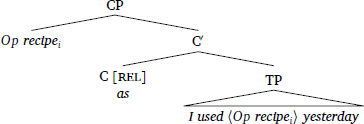 |
Here I follow Fox (2002) by proposing that the lower copy of recipe undergoes Trace Conversion (adopted also in Hulsey & Sauerland 2006), as schematized in (93):
| (93) | Trace Conversion (Fox 2002: 67) | |
| a. | Variable Insertion: (Det) Pred → (Det) [Pred λ y(y=x)] | |
| b. | Determiner Replacement: (Det) [Pred λ y(y=x)] → the [Pred λ y(y=x)] | |
The composition of the clause embedded by as is then as in (94) following trace conversion and λ-abstraction triggered by movement (Heim & Kratzer 1998), assuming that the relative operator does not make a semantic contribution:35
| (94) | [[as I used the recipe x yesterday]]: λxe[I used the recipe x yesterday] |
As discussed in Section 4, in order for the embedded clause to compose with same (95) (repeated from (51)), it needs to denote an individual, rather than a property.
| (95) | [[same]]: λ xe λ ye[y = x] |
I therefore propose that the meaning of the as-clause in (94) undergoes the iota type-shift (Partee 1986), on a par with the proposal for definite free relatives by Caponigro (2003; 2004) and for degree equatives by Anderson & Morzycki (2015) (cp. Charnavel (2015), and cf. Matushansky (2010a), who makes use of a max-operator instead; her account also differs in several respects, and she is not explicit about adopting either a matching or raising analysis).
| (96) | [[as I used the recipe x yesterday]]: ιxe[I used the recipe x yesterday] ι-shift |
The meaning of the embedded clause is now of the correct type to saturate the first argument of same, and composition with the matrix NP proceeds as in (97):36
| (97) | 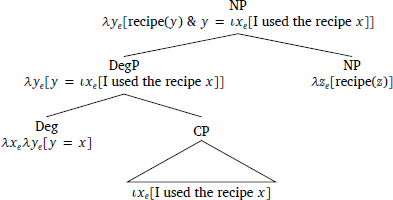 |
The resulting meaning of the matrix DP containing the as-relative is then the unique recipe that is identical to the unique recipe that the speaker used, as in (98):
| (98) | [[the same recipe as I used]]: ι ye[recipe(y) & y = ιxe[I used the recipe x]] |
6.4 As-relatives vs. that-relatives
In this final subsection, I focus on the generalization that, like as-relatives, that-relatives license the presence of same, even though there is no antecedent in such contexts.
| (99) | Today I used the same pancake recipe [rc that I used yesterday ]. |
There are in principle two possible sources for that-relatives with same. The first is that same is simply an optional modifier in relative clauses, and that the relative clause adjoins to the NP in the typical way. In this approach, same selects for idx in the same way it does in anaphora, since no as-relative is present to saturate its first argument:
- (100)
- ‘that’-relative with ‘same’ (to be rejected)
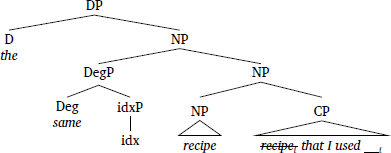
This approach however faces a problem, given the anaphoric nature of same when it does not select for a relative clause: If same first composes with the idx and then the relative clause, we will arrive at a meaning for the entire DP as in (101), which results in an anaphoric meaning for a DP that is not necessarily anaphoric.
- (101)
- [[(100)]]g: ιxe[recipe(x) & x = g(i) & I used the recipe x]
As with as-relatives, the puzzle is again however that same is licensed in relative clauses even when no antecedent is present, and thus anaphoricity should not be built in.37
The second option, proposed by Matushansky (2010b), is that same selects for that-relatives in the same way it does for as-relatives. I adopt this option here and provide novel empirical evidence in support of it. On the present account, this means that the embedded CP is selected for by Deg, as in (102) (and undergoes extraposition just like the as-relative does). On this view, the relative clause is not a nominal modifier as normal restrictive relatives are, but is instead an argument of Deg (102), just like an as-relative is.38 This precludes the selection of idx and avoids an unnecessary anaphoric interpretation.
- (102)
- ‘that’-relative with ‘same’
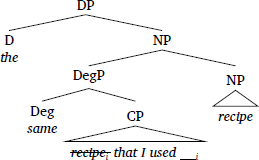
Because the that-relative, like the as-relative, is property denoting, it saturates the first argument of same in exactly the same way that the as-relative does after undergoing an iota type shift. In the present proposal, the meaning of (102) is then as in (103):
| (103) | [[(102)]]: ιye[recipe(y) & y = ιxe[I used the recipe x]] |
Note the parallel here to anaphora with and without same. Restrictive relative clauses with and without same appear to be almost identical, differing only in the presence of a modifier, they in fact arise from different underlying structures; while it may seem that same is simply an optional modifier, its presence is in fact indicative of the presence of a degree structure.
Empirical support for this proposal comes from languages that make use of the same marker in equatives and relative clauses. Spanish is one such language, which uses the invariant relativizer que in both relatives with same (104) and those without (105).39
- (104)
- Juan
- Juan
- leyó
- read
- el
- the
- mismo
- same
- libro
- book
- [as-rc
- que
- that
- leyó
- read
- Pedro ].
- Pedro
- ‘John read the same book that Pedro read.’
- (105)
- Juan
- Juan
- leyó
- read
- el
- the
- libro
- book
- [rc
- que
- that
- leyó
- read
- Pedro ].
- Pedro
- ‘John read the book that Pedro read.’
Importantly, relative clauses with and without same can nevertheless be distinguished based on the deletion they allow. In case same is present, the standard may be phrasal (106). If same is omitted however, the sentence becomes ungrammatical (107).
- (106)
- Juan
- Juan
- leyó
- read
- el
- the
- mismo
- same
- libro
- book
- [as-rc
- que
- that
- Pedro ].
- Pedro
- ‘John read the same book as Pedro.’
- (107)
- *Juan
- Juan
- leyó
- read
- el
- the
- libro
- book
- [rc
- que
- that
- Pedro ].
- Pedro
- Intended: ‘John read the book that Pedro [read].’
This contrast is not expected if same is simply an adjective that modifies an NP independently from the relative clause. The grammaticality of (106) can be explained however if same is a degree head that selects for the relative clause in such cases. What we observe then in Spanish is optionality of the size of the standard, which is expected: As a result of deletion processes restricted to comparatives and equatives, phrasal standards are allowed in degree clauses, but not in relative clauses, and can be independently accounted for (with either the direct or reduction analyses in the terminology of Lechner 2004; Bhatt & Takahashi 2011, see also Merchant 2009).
In sum, by adopting the structure of relative clauses with same as in (102), we can explain the same obviation of anaphoricity that is observed in as-relatives, as well as the size of deletion effects in a language like Spanish. In cases where same is present, a degree syntax is present rather than a typical modifying restrictive relative clause.
I conclude briefly by comparing the account here to the one proposed by Matushansky (2010a), which my account builds on. A crucial component of Matushansky’s analysis is that as-relative formation involves the movement of a null operator – housed in an AP modifying the NP – to Spec CP, to the exclusion of the gapped NP, as shown in (108):
- (108)
The motivation for this aspect of her analysis is to derive what she describes as obligatory Verb Phrase Ellipsis (VPE) as in (109), which is not required in restrictive relatives (110).
| (109) | VPE in as-relatives (reported by Matushansky 2010b) |
| Lucius likes the same flowers [as-rc as his father *likes/does ]. |
| (110) | VPE in that-relatives |
| Lucius likes the same flowers [rc that his father likes/does ]. |
In (108), the movement of the operator to Spec CP to the exclusion of the NP it modifies constitutes a Left Branch violation (Ross 1967; Corver 1990). Matushansky therefore aims to derive the obligatory deletion observed in (109) through Kennedy and Merchant’s (2002) notion of salvation by deletion (Lasnik 1995): In order to rescue the violation incurred, all material following the moved operator must be deleted, in line with the proposal that ellipsis may serve as a rescue operation for PF violations. That-relatives then differ from as-relatives in the amount of material that undergoes movement: In relative clauses, the entire gapped DP moves to Spec, CP, rather than just the operator.
Matushansky’s analysis however faces an empirical problem: The generalization that as-relatives obligatorily involve Verb Phrase Ellipsis is inaccurate, as attested by native speaker judgments as well as the following naturally-occurring example (111); Matushansky’s analysis erroneously predicts obligatory VPE in all as-relatives.40
| (111) | But with experience you can play the same game as you played before and you can forget the crowd.41 |
In the present proposal, the optional ellipsis found in as-relatives is instead on a par with VPE observed in this type of antecedent-contained deletion (Sag 1976; May 1985; Larson & May 1990; Wold 1995; Merchant 2000; Fox 2002; Kennedy 2002b; Bhatt & Pancheva 2004).
To summarize, I have argued in this section for a matching analysis of as-relatives that closely relates them to that-relatives, differing only in whether the relative clause is an NP modifier, or selected by Deg inside of a DegP modifier. I have also argued that that-relatives with same arise from the same equative syntax as as-relatives, and have shown that if such relatives follow a degree syntax, we can understand why we observe deletion therein on a par with comparative clauses. Unlike English, Spanish does not differentiate morphologically between as-relatives and that-relatives introduced by same, but still offers clues that that-relatives may have two distinct structural sources. One of these sources is facilitated by an underlying degree syntax, supporting the view that same is not an adjective, but an equative head.
7 Conclusion
The advent of proposals for structurally-encoded indices in anaphoric expressions has increased our understanding of the structure of the DP, while also raising new and important questions about the relationship between anaphora and modification. This work has contributed to this line of enquiry by demonstrating that the view from same-modification reveals that there are distinct paths to anaphora in definite descriptions, which differ according to the position in which idx is introduced. That this is the case is corroborated by a previously unsolved puzzle from German P-D contraction in anaphora with same.
Further, it has been demonstrated that the ability of same to introduce anaphora boils down to the fact that it is an equative head, a proposal which makes sense of an observed alternation between anaphora and relativization, and which leads to a unified analysis for equative degree heads in terms of their selectional properties. Ultimately, the assimilation of same to an equative head that relates individuals rather than degrees casts light on the close relationship between degrees and individuals in both modification and relativization of various kinds, revealing that the syntax may reflect coherence across even distinct ontological types.
Abbreviations
prt = particle, rel = relative pronoun
Notes
- I use the term ‘familiar’ rather than ‘anaphoric’, as the strong form also has a demonstrative use. [^]
- I refer to such contexts as cross-sentential anaphora, cf. the notion of second-mention definite descriptions in Hawkins 1978: 86. [^]
- Schwarz (2009: 44) points out that the distributions of the strong and weak forms overlap in some cases. My focus is however on the syntactic underpinnings of these forms, and so I do not address this issue. [^]
- Certain phonological restrictions likewise prohibit contraction, see Schwarz 2009: 15–17. [^]
- Schwarz’s proposal uses the situation semantics of Kratzer (1989). I do not include situation variables here. [^]
- As a head, idx not only projects but also hosts featural information about the value of the semantic index it hosts, represented as a value n on the feature id, which refers to the set of natural numbers. This assumption is in line with a range of arguments for the treatment of indices as features (Rezac 2004; Hicks 2009; Kratzer 2009; Kennedy 2014; Grosz 2015; Klecha & Martinović 2015; Clem To appear;; Arregi & Hanink 2021). [^]
- Cf. Embick’s (2010) and Svenonius’s (2012) on P-D contraction in French, which is licensed differently. [^]
- Many dialects exhibit a distinction between strong and weak forms of the definite article. However, this distinction is sometimes encoded through distinct paradigms (see e.g., Ebert 1971a; b on Fering, and Schwager 2007; Simonenko 2014 on Bavarian). The current account can be extended to such cases if the spell-out of D is sensitive to the local presence of idx, an instance of contextual allomorphy. [^]
- Schwarz (2009) in fact shows this with the antiquated form selbig (attributed to Angelika Kratzer), but the facts remain the same with the more contemporary selb, at least in cross-sentential anaphora (cf. fn. 23). [^]
- The data from German here and throughout the paper have been discussed and corroborated with at least 5 native speakers, all of whom prefer contraction with selb. [^]
- As diagnosed by stress patterns, dasˈselb does not form a complex word, cf. ‘derjenig- (Blümel 2011). [^]
- The judgement here is acceptable if the as-clause is interpreted as an as-parenthetical (see Potts 2002; LaCara 2015). [^]
- I do not address the internal reading of same here, though see Barker (2007), who proposes that this use is unrelated, and Matushansky (2010b) and Charnavel (2015) for opposing views. [^]
- The facts are the same in German. That same with an as-relative does not require resolution via an antecedent is consistent with the behavior of P-D contraction in as-relatives, which exhibit contraction whether an antecedent is present (i) or not (ii). However, because contraction is predicted with same whether an antecedent is present or not, I do not discuss such examples further.
- (i)
- Hanne wohnt in einem großen Haus in Hamburg, Maria in einem kleinen.
- Hanne lives in a big house in Hamburg, Maria in a small one.
- Eva
- Eva
- wohnt
- lives
- zur
- to.the
- Zeit
- time
- im/#in
- in.the/#in
- dem
- the
- selben
- same
- Haus
- house
- wie
- as
- Hanne.
- Hanne
- ‘At the moment, Eva lives in the same house as Hanne.’
[^]- (ii)
- Topinambur
- Jersualem.artichoke
- gehört
- belongs
- zur/#zu
- to.the/#to
- der
- the
- selben
- same
- Gattung
- genus
- wie
- as
- die
- the
- Sonnenblume.
- sunflower
- ‘Jersualem artichoke belongs to the same genus as the sunflower.’
- Alrenga et al. (2012) propose that the than-clause in comparatives is related to the degree head in a different way than presented here, occupying a position outside DegP (see also Bhatt & Pancheva 2004). The exact relation between Deg and its standard is not crucial here. Following Guéron & May (1984), surface word order is derived by extraposition of the standard. [^]
- Landman (2006) treats such as the composition of the degree element so along with like. [^]
- I leave the precise syntactic representation of implicit kind and degree arguments to future work. [^]
- The ‘as’ element is treated on a par with a wh-element, resulting in a property-denoting free relative. [^]
- Anderson & Morzycki (2015) assume that DegP and NP compose via Predicate Modification. [^]
- Barker (2007) treats same an adjective partly on the basis that it can be modified by very (i).
I argue that this very is not in fact a gradable modifier, but is a slack regulator in the sense of Lasersohn 1999. As on its use in superlatives (iia) and demonstratives (iib), it serves as a precision device. In this use very has a meaning similar to exactly.
(i) I saw the very same dog as you. [^](ii) a. The Himalayas have many peaks, but Everest is the very tallest. b. I wore that very same dress just last week. - Corroborating historical evidence against the treatment of same as an adjective comes moreover from evidence in Breban 2010 that same did not develop historically as an adjective, but as an intensifier. This stands in contrast even to other elements expressing equation such as ‘identical’, as well as the anaphoric modifier ‘different’. Breban argues that the grammaticalization path shifted same from an element “emphasizing identification to [one] establishing/contributing to the identification” (p. 240). [^]
- Some authors have suggested that same is an adjective that obligatorily co-occurs with a null equative head (Oxford 2010; Sun 2020; 2021). Relatedly, Bacskai-Atkari (2016) proposes that a DegP only has a degree semantics if a gradable predicate is in Spec, DegP; this semantics is not tied to Deg on its own. [^]
- The meaning of same is certainly more complex; it has been argued for example to have an additive component, and moreover to place a restriction on eventualities (Hardt et al. 2012; Hardt & Mikkelsen 2015). A reviewer also points out that definites without and without same appear to carry different presuppositions. These important questions are however beyond the scope of the present work. [^]
- A reviewer raises the question of why we don’t see an overt pronoun as the realization of idx. While I do not offer a complete analysis of pronouns, there are works arguing that pronouns are D+idx, rather than idx itself (Elbourne 2005; Patel-Grosz & Grosz 2017; Hanink 2021). I also note that in Hebrew, the 3rd person masculine pronoun ‘oto may also appear as a modifier with the meaning of same (Itamar Francez, p.c.; see also Matushansky 2010b; Hanink 2017). [^]
- Cp. Schwarz (2009: 266), who suggests that same might play the same role as the index. [^]
- A reviewer raises the question of what governs the use of same if it does not differ in meaning from a simple DP. One possibility here is to invoke for example Meyer’s (2013) Efficiency principle, which rules out redundant structures if there is a simpler competitor. See also footnote 23. [^]
- Cinque (2005) and Kayne (2005) suggest an intermediate view, that same is a functional adjective. [^]
- Interestingly, (Schwarz 2009: 266) reports examples such as (iv) as bad if antiquated selbig- is used, a judgement shared by the speakers I consulted with. There is therefore a contrast here with selb-. [^]
- All 5 speakers consulted with preferred contraction in this example. [^]
- Many other expressions express equality (e.g. generic equatives) or similarity (e.g. similatives); see Rett 2013. [^]
- See Potts 2002 and Rett 2013 for arguments against treating as as C. [^]
- Subcomparatives seem to work with nouns that denote measurements, as shown in (i):
The difference observed in deletion effects is likely a result of the fact that these examples do not involve the equation of token individuals, but of types or amounts; see Kennedy 2002a. Same here seems to impose identity between degrees, as suggested by the possible paraphase in (ii):
(i) Each individual pixel has the same height as it does ____ width. [^](ii) Each individual pixel has the same degree of height as it does ____ width. - In related work, Sauerland (2004) and Hulsey & Sauerland (2006) define this deletion operation in terms of movement deletion, see also Kennedy 2002b. [^]
- The alternative to this matching analysis is a raising analysis. One of the key pieces of evidence for the raising analysis (see Bhatt 2002) is the availability of idioms, which require locality for interpretation (Brame 1968). These data are difficult to replicate with same, but where possible, the presence of same appears to give rise to an amount relative (Carlson 1977a; Heim 1987; Grosu & Landman 1998) rather than an individual one (i). In this case, a different interpretation may be needed altogether, along the lines of those proposed for amount relatives (Carlson 1977a; Heim 1987; Grosu & Landman 1998).
[^]
(i) Hanne made the same headway [as-rc as Mary did ]. - Where the recipe x is shorthand for: ι y[recipe(y) & y = x]. An alternative is to treat the argument in base position as a content-specified trace (Sauerland 2003), as in (i):
[^]
(i) ⟦xrecipe⟧g = g(x) iff g(x) ∈ [[recipe]]; else undefined - I follow Sauerland’s (2004) proposal that the internal head of the relative clause is only interpreted in its base position. [^]
- In German, contraction is also preferred in relative clauses with same, cp. footnote 11. Notably, restrictive relatives without same do not permit contraction. See Hanink & Grove (2017) for an analysis. [^]
- See Simonenko 2014 for a related proposal for restrictive relatives without same in Austro-Bavarian, cf. Hanink & Grove’s (2017) proposal for Standard German. [^]
- The Spanish data come from personal communication with Karlos Arregi. [^]
- Charnavel (2015) notes that in French, the as-relative must be at least partially elided. [^]
- https://www.dailyrecord.co.uk/sport/football/relaxed-rangers-will-have-no-fear-of-old-1003119. [^]
Acknowledgements
I am indebted to Artemis Alexiadou, Karlos Arregi, Itamar Francez, Julian Grove, Anastasia Giannakidou, Andrew Koontz-Garboden, Chris Kennedy, Jason Merchant, Florian Schwarz, Ming Xiang, and audiences at the Humboldt-Universität zu Berlin, Universität Konstanz, UCLA, PLC 40, and Selection Fest Berlin for their feedback on various parts of this work. I also thank Sven Beller, Anya Falck, Dorothea Hoffmann, Jens Hopperdietzel, Vera Hohaus, and Richard Zimmermann for sharing their judgements on German. Finally, I thank the anonymous reviewers at Glossa for their constructive feedback on this paper. All errors and shortcomings are my own.
Funding Information
This work has been funded in part by European Research Council Consolidator Grant ERC-2017-COG 769192 (PI: Andrew Koontz-Garboden).
Competing Interests
The author has no competing interests to declare.
References
Alexiadou, Artemis & Haegeman, Liliane M.V. & Stavrou, Melita. 2007. Noun Phrase in the Generative Perspective. Amsterdam: John Benjamins. DOI: http://doi.org/10.1515/9783110207491
Alrenga, Peter. 2006. Scalar (Non-)Identity and Similarity. In Baumer, Donald & Montero, David & Scanlon, Michael (eds.), The Proceedings of the WCCFL 25, 49–57. Somerville, MA: Cascadilla.
Alrenga, Peter. 2007. Dimensions in the semantics of comparatives: UC Santa Cruz dissertation.
Alrenga, Peter. 2009. Types Tokens and Identity. In Schardl, Anisa & Walkow, Martin & Abdurrahman, Muhammad (eds.), Proceedings of NELS 38, 53–64. Amherst, MA: GLSA.
Alrenga, Peter & Kennedy, Christopher & Merchant, Jason. 2012. A New Standard of Comparison. In Arnett, Nathan & Bennett, Ryan (eds.), The Proceedings of the WCCFL 30, 32–42. Somerville, MA: Cascadilla.
Anderson, Curt & Morzycki, Marcin. 2015. Degrees as kinds. Natural Language & Linguistic Theory 33.3. 791–828. DOI: http://doi.org/10.1007/s11049-015-9290-z
Arkoh, Ruby & Matthewson, Lisa. 2013. A familiar definite article in Akan. Lingua 123. 1–30. DOI: http://doi.org/10.1016/j.lingua.2012.09.012
Arregi, Karlos & Hanink, Emily A. 2021. Switch reference as index agreement. Natural Language & Linguistic Theory (Online First). DOI: http://doi.org/10.1007/s11049-021-09521-2
Bacskai-Atkari, Julia. 2016. Equative elements in comparative constructions and in relative clauses in the history of German and English. Slides from a talk at Universität zu Köln.
Baglini, Rebekah. 2015. Stative predication and semantic ontology: A cross-linguistic study. Chicago: University of Chicago dissertation.
Baker, Mark & Johnson, Kyle & Roberts, Ian. 1989. Passive arguments raised. Linguistic Inquiry 20. 219–251.
Barker, Chris. 2007. Parasitic scope. Linguistics and Philosophy 30(4). 407–444. DOI: http://doi.org/10.1007/s10988-007-9021-y
Beck, Sigrid. 2000. The Semantics of “Different”: Comparison Operator and Relational Adjective. Linguistics and Philosophy 23(2). 101–139. DOI: http://doi.org/10.1023/A:1005566722022
Beck, Sigrid & Hohaus, Vera & Tiemann, Sonja. 2012. A note on phrasal comparatives. In Proceedings of Semantics and Linguistic Theory 22. 146–165. Washington, DC: Linguistics Society of America. DOI: http://doi.org/10.3765/salt.v22i0.2654
Bhatt, Rajesh. 2002. The raising analysis of relative clauses: Evidence from adjectival modification. Natural Language Semantics 10(1). 43–90. DOI: http://doi.org/10.1023/A:1015536226396
Bhatt, Rajesh & Pancheva, Roumyana. 2004. Late merger of degree clauses. Linguistic Inquiry 35(1). 1–45. DOI: http://doi.org/10.1162/002438904322793338
Bhatt, Rajesh & Pancheva, Roumyana. 2006. Implicit arguments. In Everaert, M. & van Riemsdijk, H. & Goedemans, R. & Hollebrandse, B. (eds.), The Blackwell companion to syntax 2. 554–584. Malden: Wiley-Blackwell.
Bhatt, Rajesh & Takahashi, Shoichi. 2011. Reduced and unreduced phrasal comparatives. Natural Language & Linguistic Theory 29. 581–620. DOI: http://doi.org/10.1007/s11049-011-9137-1
Bianchi, Valentina. 2002. Headed relatives in generative syntax. In Glot International, vol. 6, Malden, MA: Blackwell.
Blümel, Andreas. 2011. Derjenige determiner that wants a relative clause. In Alexiadou, Artemis & Wilder, Chris (eds.), University of Pennsylvania Working Papers in Linguistics 17. 21–29. Philadelphia: UPenn.
Bobaljik, Jonathan. 1994. What does adjacency do? In The morphology-syntax connection 21. 1–32. Cambridge: MITWPL.
Bolinger, Dwight Le Merton. 1972. Degree Words. The Hague: Mouton. DOI: http://doi.org/10.1515/9783110877786
Bombi, Carla. 2018. Definiteness in Akan: Familiarity and uniqueness revisited. In Maspong, Sireemas & Stefánsdóttir, Brynhildur & Blake, Katherine & Davis, Forrest (eds.), The Proceedings of Semantics and Linguistic Theory 28, 141–160. Linguistic Society of America. DOI: http://doi.org/10.3765/salt.v28i0.4406
Brame, Michael. 1968. A new analysis of the relative clause: evidence for an interpretive theory. Ms., MIT.
Brandner, Ellen. 2016. Zur indefiniten Determiniererverdopplung im Alemannischen (und darüber hinaus). Talk delivered at: SaRDiS 2016: Saarbrücker Runder Tisch für Dialektsyntax, Saarbrücken, Universität des Saarlandes, November 2016.
Brasoveanu, Adrian. 2011. Sentence-internal different as quantifier-internal anaphora. Linguistics and Philosophy 34(2). 93–168. DOI: http://doi.org/10.1007/s10988-011-9096-3
Breban, Tine. 2010. English adjectives of comparison: Lexical and grammatical uses. Berlin: de Gruyter. DOI: http://doi.org/10.1515/9783110216011
Bresnan, Joan. 1973. Syntax of the Comparative Clause Construction in English. Linguistic Inquiry 4. 275–343.
Bresnan, Joan. 1975. Comparative Deletion and Constraints on Transformations. Linguistic Analysis 1. 25–74.
Bumford, Dylan & Barker, Chris. 2013. Association with distributivity and the problem of multiple antecedents for singular different. Linguistics and Philosophy 36(5). 355–269. DOI: http://doi.org/10.1007/s10988-013-9139-z
Caponigro, Ivano. 2003. Free Not to Ask: On the Semantics of Free Relatives and Wh-words Cross-linguistically. Ph.D. Dissertation, UCLA.
Caponigro, Ivano. 2004. The semantic contribution of wh-words and type shifts: Evidence from free relatives crosslinguistically. In Young, Robert B. (ed.), The Proceedings of Semantics and Linguistic Theory 14, 38–55. Ithaca, NY: CLC Publications. DOI: http://doi.org/10.3765/salt.v14i0.2906
Carlson, Greg. 1977a. Amount Relatives. Language 53. 520–542. DOI: http://doi.org/10.2307/413175
Carlson, Greg. 1977b. Reference to Kinds in English: UMass Amherst dissertation.
Carlson, Greg. 1987. Same and different: some consequences for syntax and semantics. Linguistics and Philosophy 10(4). 531–565. DOI: http://doi.org/10.1007/BF00628069
Castroviejo-Miró, Elena. 2011. ‘So’ as a weak degree expression. In Ashton, Neil & Chereches, Anca & Lutz, David (eds.), Proceedings of Semantics and Linguistic Theory 21, 76–94. Linguistic Society of America. DOI: http://doi.org/10.3765/salt.v21i0.2624
Charnavel, Isabelle. 2010. On the sentence-internal reading of French le même (‘the same’). In Li, Nan & Lutz, David (eds.), The Proceedings of Semantics and Linguistic Theory 20, 216–232. Linguistic Society of America. DOI: http://doi.org/10.3765/salt.v20i0.2567
Charnavel, Isabelle. 2015. Same, different and other as comparative adjectives – A uniform analysis based on French. Lingua 156. 129–174. DOI: http://doi.org/10.1016/j.lingua.2014.12.005
Chierchia, Gennaro. 1985. Formal semantics and the grammar of predication. Linguistic Inquiry 16. 416–444.
Chomsky, Noam. 1965. Aspects of the Theory of Syntax. MIT. DOI: http://doi.org/10.21236/AD0616323
Chomsky, Noam. 1977. On wh-movement. In Culicover, Peter W. & Wasow, Thomas & Akmajian, Adrian (eds.), Formal syntax, 71–132. New York Academic Press.
Chomsky, Noam. 1981. Lectures on Government and Binding. Foris.
Cieschinger, Maria. 2006. Constraints on the contraction of preposition and definite article in German. B.A. Thesis, Universität Osnabrück.
Cinque, Guglielmo. 2005. Deriving Greenberg’s Universal 20 and its exceptions. Linguistic Inquiry 36. 315–332. DOI: http://doi.org/10.1162/0024389054396917
Clark, Herbert H. 1975. Bridging. Proceedings of the 1975 workshop on theoretical issues in natural language processing. DOI: http://doi.org/10.3115/980190.980237
Clem, Emily. To appear. Cyclic expansion in Agree: Maximal projections as probes. Linguistic Inquiry.
Condoravdi, Cleo & Gawron, Jean-Mark. 1996. The context-dependency of implicit arguments. In Kanazawa, M. & Piñón, C. & de Swart, H. (eds.), Quantifiers, Deduction, and Context, 1–32. Stanford: CSLI Publications.
Corver, Norbert. 1990. The syntax of Left Branch Constructions: Tilburg University dissertation.
Creswell, Max J. 1976. The semantics of degree. In Partee, Barbara (ed.), Montague Grammar, 261–292. New York: Academic Press. DOI: http://doi.org/10.1016/B978-0-12-545850-4.50015-7
de Vries, Mark. 2002. The Syntax of Relativization: Utrecht University dissertation.
Dotlačil, Jakub. 2010. Anaphora and Distributivity. A study of same, different, reciprocals and others: Universiteit Utrecht dissertation.
Dowty, David. 1985. A Unified Indexical Analysis of Same and Different, a Response to Stump and Carlson. Paper presented at the University of Texas Workshop on Syntax and Semantics, Austin, TX, March 1985.
Ebert, Karin. 1971a. Referenz, Sprechsituation und die bestimmten Artikel in einem Nordfriesischen Dialekt (Fering): Christian-Albrechts-Universität zu Kiel dissertation.
Ebert, Karin. 1971b. Zwei Formen des bestimmten Artikels. In Wunderlich, D. (ed.), Probleme und Fortschritte der Transformationsgrammatik, 159–174. Hueber: München.
Elbourne, Paul. 2005. Situations and individuals. MIT Press.
Embick, David. 2010. Localism versus globalism in morphology and phonology, vol. 60. MIT Press. DOI: http://doi.org/10.7551/mitpress/9780262014229.001.0001
Embick, David & Noyer, Rolf. 2001. Movement operations after syntax. Linguistic Inquiry 32(4). 555–595. DOI: http://doi.org/10.1162/002438901753373005
Emonds, Joseph E. 1985. A Unified Theory of Syntactic Categories. Dordrecht: Foris. DOI: http://doi.org/10.1515/9783110808513
Fiengo, Robert & May, Robert. 1994. Indices and identity. MIT Press.
Fox, Danny. 2002. Antecedent contained deletion and the copy theory of movement. Linguistic Inquiry 33(1). 63–96. DOI: http://doi.org/10.1162/002438902317382189
Grosu, Alexander. 2002. Strange relatives at the interface of two millennia. Linguistic Inquiry, 257–293.
Grosu, Alexander. 2012. Towards a more articulated typology of internally headed relative constructions: the semantics connection. Language and Linguistics Compass, 1–30. DOI: http://doi.org/10.1002/lnc3.346
Grosu, Alexander & Landman, Fred. 1998. Strange relatives of the third kind. Natural Language Semantics 6(2). 125–170. DOI: http://doi.org/10.1023/A:1008268401837
Grosz, Patrick. 2015. Movement and agreement in Right-Node Raising Constructions. Syntax 18. 1–38. DOI: http://doi.org/10.1111/synt.12024
Guéron, Jacqueline & May, Robert. 1984. Extraposition and logical form. Linguistic Inquiry 15. 1–31.
Haberland, Hartmut. 1985. Zum Problem der Verschmelzung von Präposition und bestimmtem Artikel im Deutschen. Osnabrücker Beiträge zur Sprachtheorie, 30.
Halle, Morris & Marantz, Alec. 1993. Distributed Morphology and the pieces of inflection. The view from building 20, 111–176.
Hanink, Emily. 2017. The German definite article and the ‘sameness’ of indices. In Djärv, Kajsa & Davies, Amy Goodwin (eds.), Penn Working Papers in Linguistics, vol. 23.1, University of Pennsylvania.
Hanink, Emily A. 2018. Structural Sources of Anaphora and Sameness: University of Chicago dissertation.
Hanink, Emily A. 2021. DP structure and internally headed relatives in Washo. Natural Language & Linguistic Theory 39(2). 505–554. DOI: http://doi.org/10.1007/s11049-020-09482-y
Hanink, Emily & Grove, Julian. 2017. German Relative Clauses and the Severed Index Hypothesis. In Kaplan, A. & Kaplan, A. & McCarvel, MK. & Rubin, EJ. (eds.), The Proceedings of the West Coast Conference on Formal Linguistics 34, 241–248. Somerville, MA: Cascadilla.
Hardt, Daniel & Mikkelsen, Line. 2015. Same but different. Linguistics and Philosophy 38(4). 289–314. DOI: http://doi.org/10.1007/s10988-015-9176-x
Hardt, Daniel & Mikkelsen, Line & Ørsnes, Bjarne. 2012. Sameness, Ellipsis, and Anaphora. In Aloni, M. & Kimmelman, V. & Roelofsen, F. & Sassoon, G. & Schulz, K. & Westera, M. (eds.), The Proceedings of the 2011 Amsterdam Colloquium, 341–250. Berlin: Springer.
Hartmann, Dietrich. 1978. Verschmelzungen als Varianten des bestimmten Artikels? In D. Hartmann, H.J. Linke & Ludwig, O. (eds.), Sprache in Gegenwart und Geschichte. Festschrift Für Heinrich Matthias Heinrichs, 68–81. Böhlau: Köln.
Hawkins, John A. 1978. Definiteness and indefiniteness: A study in reference and grammaticality prediction. London: Croom Helm.
Heim, Irene. 1982. The semantics of definite and indefinite noun phrases: UMass Amherst dissertation.
Heim, Irene. 1985. Notes on comparatives and related matters. Ms., MIT.
Heim, Irene. 1987. Where Does the Definiteness Restriction Apply? Evidence from the Definiteness of Variables. In Reuland, E. J. & ter Meulen, A. G. B. (eds.), The Representation of (In)definiteness, Cambridge, MA: MIT Press.
Heim, Irene & Kratzer, Angelika. 1998. Semantics in generative grammar, vol. 13. Oxford: Blackwell.
Hicks, Glyn. 2009. The derivation of anaphoric relations. Amsterdam: John Benjamins. DOI: http://doi.org/10.1075/la.139
Hohaus, Vera. 2015. Context and composition: How presuppositions manipulate the interpretation of free variables: Universität Tübingen dissertation.
Horn, Larry. 1972. On the semantic properties of logical operators in English: UCLA dissertation.
Huddleston, Rodney & Pullum, Geoffrey K. 2002. The Cambridge Grammar of the English Language. Cambridge: Cambridge University Press. DOI: http://doi.org/10.1017/9781316423530
Hulsey, Sarah & Sauerland, Uli. 2006. Sorting out relative clauses. Natural Language Semantics 14(2). 111–137. DOI: http://doi.org/10.1007/s11050-005-3799-3
Jenks, Peter. 2018. Articulated definiteness without articles. Linguistic Inquiry 49(3). 501–536. DOI: http://doi.org/10.1162/ling_a_00280
Kayne, Richard. 1994. The Antisymmetry of Syntax. MIT Press.
Kayne, Richard. 2005. Some notes on comparative syntax, with special reference to English and French. In Cinque, Guglielmo & Kayne, Richard (eds.), The Oxford Handbook of Comparative Syntax, 3–69. New York: Oxford University Press.
Kennedy, Chris. 1999. Projecting the adjective: The syntax and semantics of gradability and comparison. New York: Routledge.
Kennedy, Chris. 2002a. Comparative and Relative Clauses Compared. Handout from MIT LingLunch, 3 October.
Kennedy, Chris. 2002b. Comparative deletion and optimality in syntax. Natural Language & Linguistic Theory 20(3). 553–621. DOI: http://doi.org/10.1023/A:1015889823361
Kennedy, Chris. 2014. Predicates and formulas: Evidence from ellipsis. In Crnič, Luka & Sauerland, Uli (eds.), The Art and Craft of Semantics: A Festschrift for Irene Heim 1. 83–136. Cambridge, MA: MITWPL.
Kennedy, Chris & Merchant, Jason. 2000. Attributive comparative deletion. Natural Language & Linguistic Theory 181(1). 89–146. DOI: http://doi.org/10.1023/A:1006362716348
Klecha, Peter & Martinović, Martina. 2015. Exhaustivity, predication and the semantics of movement. In Jurgensen, Anna E. & Sande, Hannah & Lamoureux, Spencer & Baclawski, Kenny & Zerbe, Alison (eds.), Proceedings of BLS 41, 267–286. DOI: http://doi.org/10.20354/B4414110005
Kratzer, Angelika. 1989. An investigation in the lumps of thought. Linguistics and Philosophy 12(5). 607–653. DOI: http://doi.org/10.1007/BF00627775
Kratzer, Angelika. 2009. Making a pronoun: Fake indexicals as windows into the properties of pronouns. Linguistic Inquiry 40(2). 187–237. DOI: http://doi.org/10.1162/ling.2009.40.2.187
LaCara, Nicholas. 2015. Discourse Inversion and Deletion in As-parentheticals. In Kluck, Marlies & Ott, Dennis & de Vries, Mark (eds.), Parenthesis and Ellipsis: Cross-linguistic and Theoretical Perspectives, 219–245. Berlin: De Gruyter/Mouton.
Landman, Meredith. 2006. Variables in natural language: UMass Amherst dissertation.
Landman, Meredith & Morzycki, Marcin. 2003. Event-kinds and the representation of manner. In Antrim, Nancy Mae & Goodall, Grant & Schulte-Nafeh, Martha & Samiian, Vida (eds.), The Proceedings of the 2002 Western Conference on Linguistics 14. 136–147. Fresno: California State University.
Larson, Richard & May, Robert. 1990. Antecedent containment or vacuous movement: Reply to Baltin. Linguistic Inquiry 21. 103–122.
Lasersohn, Peter. 1999. Pragmatic halos. Language 75(3). 522–551. DOI: http://doi.org/10.2307/417059
Lasnik, Howard. 1995. A note on pseudogapping. In Pensalfini, Robert & Ura, Hiroyuki (eds.), Papers on minimalist syntax, 143–163. MIT Working Papers in Linguistics.
Lechner, Winfried. 2004. Ellipsis in comparatives, vol. 72. Walter de Gruyter. DOI: http://doi.org/10.1515/9783110197402
Lee-Goldman, Russell. 2012. Supplemental relative clauses: Internal and external syntax. Journal of Linguistics 48. 573–608. DOI: http://doi.org/10.1017/S0022226712000047
Lees, Robert B. 1960. The Grammar of English Nominalizations. Mouton, The Hague.
Lees, Robert B. 1961. Grammatical analysis of the English comparative construction. Word 17(2). 171–185. DOI: http://doi.org/10.1080/00437956.1961.11659752
Martí, Luisa. 2003. Contextual Variables: University of Connecticut dissertation. DOI: http://doi.org/10.3765/salt.v13i0.2882
Matushansky, Ora. 2010a. As-relatives? Ms., UiL OTS/Utrecht University/CNRS/Université Paris-8.
Matushansky, Ora. 2010b. Same problem, different solution. Ms., UiL OTS/Utrecht University/CNRS/Université Paris-8.
May, Robert. 1985. Logical Form: Its Structure and Derivation. Cambridge, MA: MIT Press.
Meier, Cécile. 2003. The Meaning of too, enough, and so… that. Natural Language Semantics 11. 69–107. DOI: http://doi.org/10.1023/A:1023002608785
Merchant, Jason. 2000. Economy, the Copy Theory, and Antecedent-Contained Deletion. Linguistic Inquiry 31(3). 566–575. DOI: http://doi.org/10.1162/002438900554460
Merchant, Jason. 2009. Phrasal and clausal comparatives in Greek and the abstractness of syntax. Journal of Greek Linguistics 9(1). 134–164. DOI: http://doi.org/10.1163/156658409X12500896406005
Meyer, Marie-Christine. 2013. Ignorance and Grammar: MIT dissertation.
Milsark, Gary. 1974. Existential Sentences in English. MIT Dissertation.
Mitchell, Jonathan E. 1986. The formal semantics point of view: University of Massachusetts, Amherst dissertation.
Moltmann, Friederike. 1992. Reciprocals and “Same/Different”: Towards a Semantic Analysis. Linguistics and Philosophy 15(4). 411–462. DOI: http://doi.org/10.1007/BF00627683
Munn, Alan. 1994. A minimalist account of reconstruction asymmetries. In Gonzàlez, M. (ed.), The Proceedings of the North East Linguistic Society 24, 397–410. Amherst, MA: GLSA.
Oxford, Will. 2010. Same, different, and other: The microsyntax of identity adjectives. Ms., University of Toronto.
Parsons, Terence. 1970. An analysis of mass terms and amount terms. Foundations of language 6(3). 362–388.
Partee, Barbara. 1986. Noun phrase interpretation and type-shifting principles. In Groenendijk, Jeroen & de Jongh, Dick & Stokhof, Martin (eds.), Studies in discourse representation theory and the theory of generalized quantifiers, 115–143. Foris. DOI: http://doi.org/10.1515/9783112420027-006
Partee, Barbara. 1989. Binding implicit variables in quantified contexts. In Wiltshire, Caroline & Graczyk, Randolph & Music, Bradley (eds.), Papers from the 25th Regional Meeting of the Chicago Linguistic Society, 342–356. Chicago: CLS.
Patel-Grosz, Pritty & Grosz, Patrick. 2017. Revisiting pronominal typology. Linguistic Inquiry 48. 259–297. DOI: http://doi.org/10.1162/LING_a_00243
Potts, Chris. 2002. The lexical semantics of parenthetical-as and appositive-which. Syntax 5. 55–88. DOI: http://doi.org/10.1111/1467-9612.00047
Rett, Jessica. 2013. Similatives and the argument structure of verbs. Natural Language & Linguistic Theory 31. 1101–1137. DOI: http://doi.org/10.1007/s11049-013-9201-0
Rezac, Milan. 2004. Aspects of Cyclic Syntax: Agree and Merge: University of Toronto dissertation.
Ritter, Elizabeth. 1991. Two functional categories in noun phrases: Evidence from Modern Hebrew. Syntax and semantics 25. 37–62. DOI: http://doi.org/10.1163/9789004373198_004
Ritter, Elizabeth. 1993. Where’s gender? Linguistic Inquiry 24. 795–803. DOI: http://doi.org/10.1016/0026-2692(93)90078-S
Ross, John Robert. 1967. Constraints on variables in syntax: MIT dissertation.
Safir, Ken. 1996. Semantic atoms of anaphora. Natural Language & Linguistic Theory 14. 545–589. DOI: http://doi.org/10.1007/BF00133598
Sag, Ivan. 1976. Deletion and Logical Form. Cambridge, MA: Massachusetts Institute of Technology dissertation.
Salzmann, Martin. 2006. Resumptive prolepsis: A study in indirect A′-dependencies: Utrecht: LOT dissertation.
Sauerland, Uli. 1998. The meaning of chains. Cambridge, MA: MIT dissertation.
Sauerland, Uli. 2003. Unpronounced heads in relative clauses. In The interfaces: Deriving and interpreting omitted structures 61. 205–226. Amsterdam: John Benjamins. DOI: http://doi.org/10.1075/la.61.10sau
Sauerland, Uli. 2004. The Interpretation of Traces. Natural Language Semantics 12(1). 63–127. DOI: http://doi.org/10.1023/B:NALS.0000011201.91994.4f
Schachter, Paul. 1973. Focus and relativization. Language 49(1). 19–46. DOI: http://doi.org/10.2307/412101
Schlenker, Philippe. 2017. Sign Language and the Foundations of Anaphora. Annual Review of Linguistics 3. 149–177. DOI: http://doi.org/10.1146/annurev-linguistics-011415-040715
Schwager, Magdalena. 2007. Functional concepts: Definite articles in Bavarian. Talk presented at the 8th Szklarska Poreba Workshop.
Schwarz, Florian. 2009. Two Types of Definites in Natural Language: UMass Amherst dissertation.
Schwarz, Florian. 2019. Weak vs. strong definite articles: Meaning and form across languages. In Aguilar-Guevera, Ana & Loyo, Julia Pozas & Maldonado, Violeta Vázquez-Rojas (eds.), Definiteness across languages, Berlin: Language Science Press.
Schwarzschild, Roger & Wilkinson, Karina. 2002. Quantifiers in comparatives: A semantics of degree based on intervals. Natural Language Semantics 10. 1–41.
Seuren, Pieter. 1984. The comparative revisited. Journal of Semantics 3. 109–141. DOI: http://doi.org/10.1093/jos/3.1-2.109
Siegel, Muffy E. 1994. Such: Binding and the Pro-Adjective. Linguistics and Philosophy 17. 481–498. DOI: http://doi.org/10.1007/BF00985832
Simonenko, Alexandra. 2014. Grammatical Ingredients of Definiteness: McGill University dissertation.
Stowell, Tim. 1987. As so, not so as. Ms., UCLA.
Sun, Yenan. 2020. Same as the parameter of an equation construction. In Franke, Michael & Kompa, Nikola & Liu, Mingya & Mueller, Jutta L. & Schwab, Juliane (eds.), The proceedings of sinn und bedeutung 24 2. 306–318. Universität Osnabrück.
Sun, Yenan. 2021. Decomposing same. Natural Language & Linguistic Theory (Online First). Svenonius, Peter. 2012. Spanning. Ms., University of Trømso. DOI: http://doi.org/10.1007/s11049-021-09522-1
Umbach, Carla. 2007. The role of so in German equative comparison. Handout from the Colloque de Syntaxe et Sémantique à Paris 2007.
Vergnaud, Jean-Roger. 1974. French relative clauses: Massachusetts Institute of Technology dissertation.
von Stechow, Arnim. 1984. Comparing semantic theories of comparison. Journal of Semantics 3. 1–77. DOI: http://doi.org/10.1093/jos/3.1-2.1
Wellwood, Alexis. 2015. On the semantics of comparison across categories. Linguistics and Philosophy 38(1). 67–101. DOI: http://doi.org/10.1007/s10988-015-9165-0
Wellwood, Alexis. 2019. The meaning of more. Oxford: Oxford University Press. DOI: http://doi.org/10.1093/oso/9780198804659.001.0001
Williams, Edwin. 2015. Arguments in Syntax and Semantics. Cambridge: Cambridge University Press. DOI: http://doi.org/10.1017/CBO9781139042864
Wold, Dag. 1995. Antecedent-Contained Deletion in Comparative Constructions. Ms, MIT.
Wood, Johanna. 2002. Much about such. Studia Linguistica 56. 91–115. DOI: http://doi.org/10.1111/1467-9582.00088

